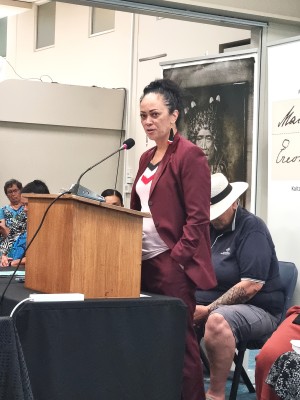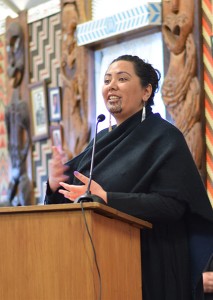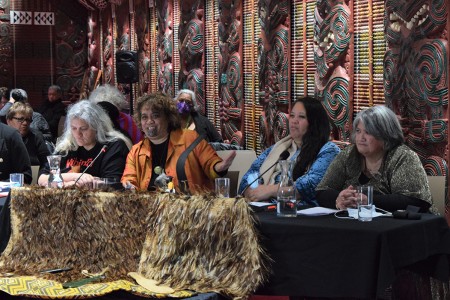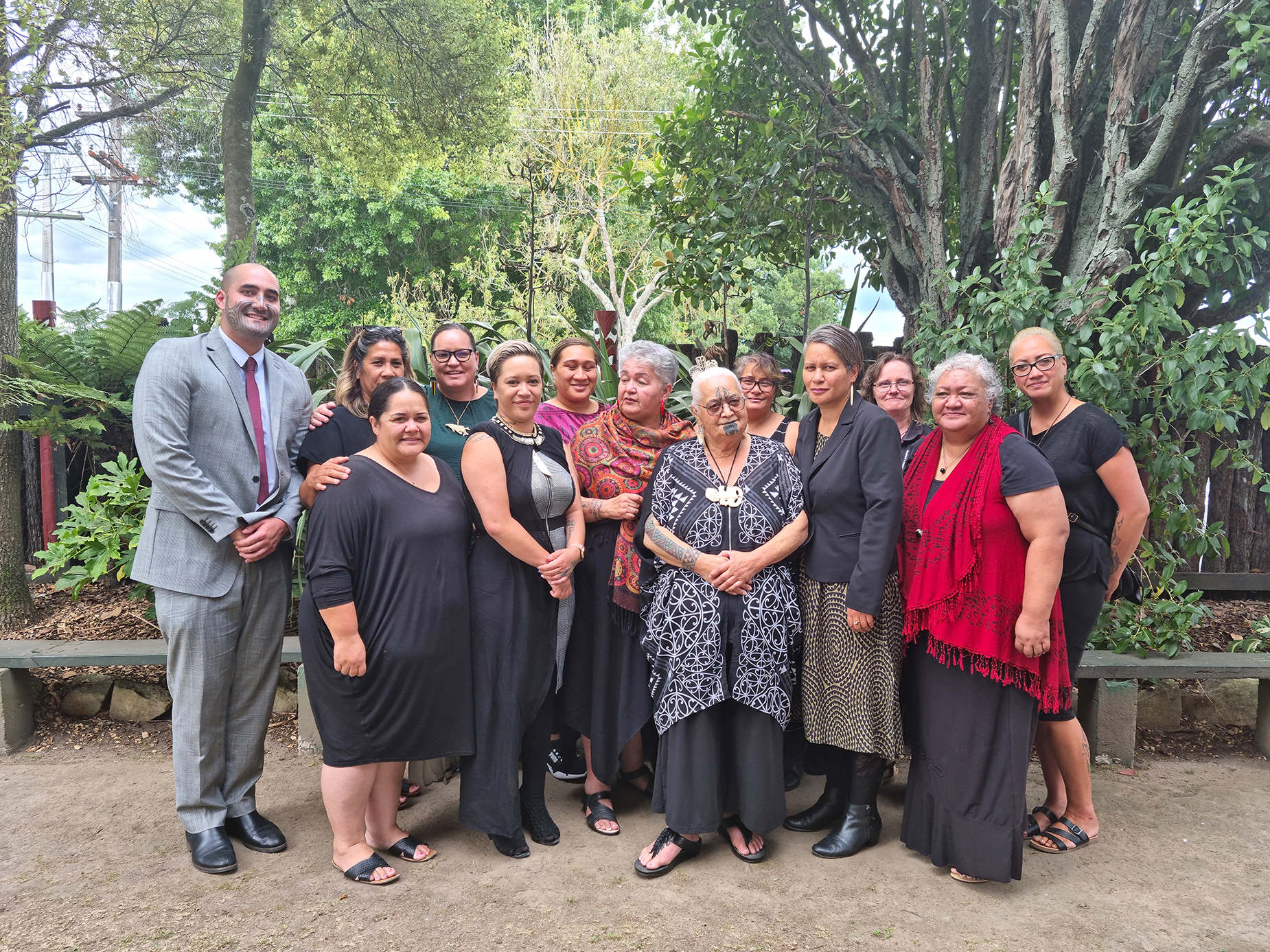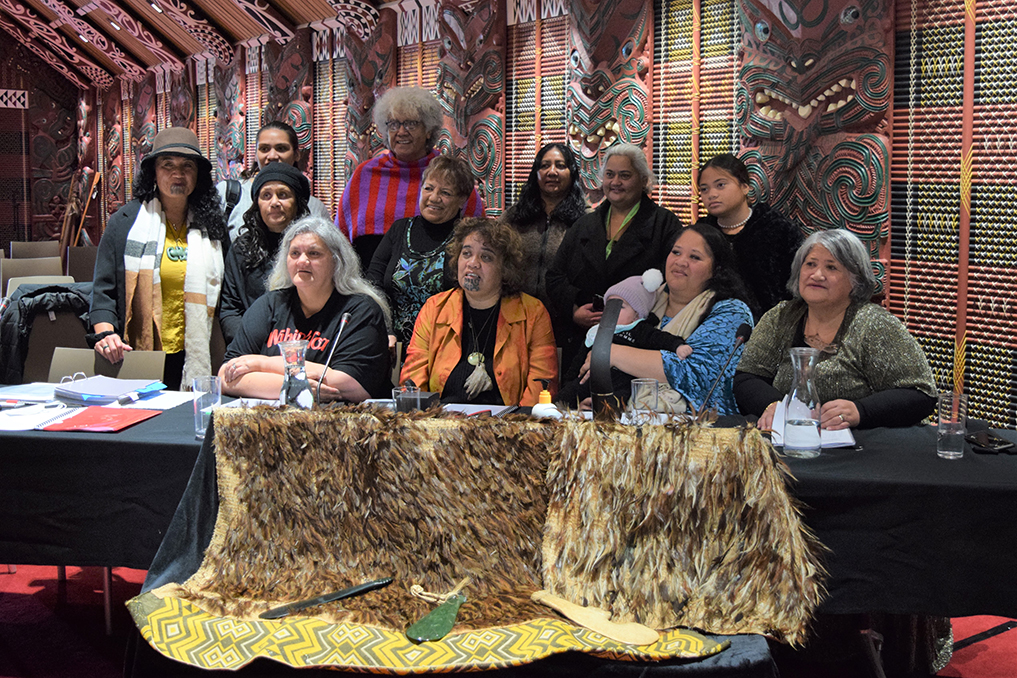Hearing participants
List of witnesses
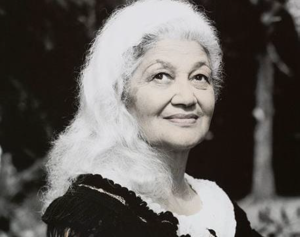
Dame Mira Szazsy, named claimant for the Māori Women’s (Wai 381) claim (pictured in document A30(c))
Witness profiles
Hearing one
Ripeka Evans
Ripeka Evans (Ngāpuhi, Ngāti Porou, Te Aupouri, Ngāti Kahu) has been an activist, consultant, chief executive and director across Māori, Crown, iwi, and hapū organisations for 45 years. Her evidence covered the genesis of the original Māori Women's (Wai 381) claim, as well as discussing wāhine signatories to Te Tiriti, particularly Ana Hamua, Takurua, Te Marama, and Te Ereonora.
The Māori Women’s (Wai 381) claim
Hearing one, Turner Centre, Kerikeri, February 2021
Read Ripeka Evan's evidence (document A21)(external link)
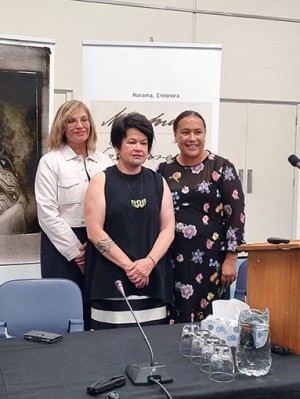
Ripeka Evans at Turner Centre, Kerikeri
Keti Marsh-Solomon
Keti Marsh-Solomon (Ngāti Toro, Te Uri Taniwha, Ngāti Ueoneone, Ngāpuhi, Ngāti Porou) gave evidence alongside her whanaunga Ripeka Evans. She told the Tribunal about her tūpuna: Turikātuku (? - 1827), Hariata Rongo (1815-1894), Te Paea Nehua, her great-grandmother Emerina Johnson, grandmother (also) Emerina Johnson, and mother Tui Dalton.
The Māori Women’s (Wai 381) claim
Hearing one, Turner Centre, Kerikeri, February 2021
Read Keti Marsh-Solomon's evidence (document A29)(external link)
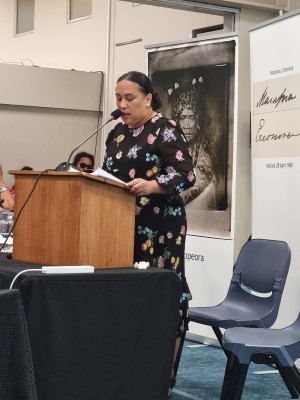
Keti Marsh-Solomon giving evidence at Turner Centre, Kerikeri
Donna Awatere-Huata
Donna Awatere-Huata is a descendant of Whānau ā Hinetāpora, Ngāti Whakaue, and Ngāti Hine. Her evidence outlined how mana atua, mana whenua, mana tangata, and mana tamariki relate to the rangatiratanga of wāhine Māori. She argued that whakapapa is key to understanding mana wāhine.
The Māori Women’s (Wai 381) claim
Hearing one, Turner Centre, Kerikeri, February 2021
Read Donna Awatere-Huata's evidence (document A20)(external link)
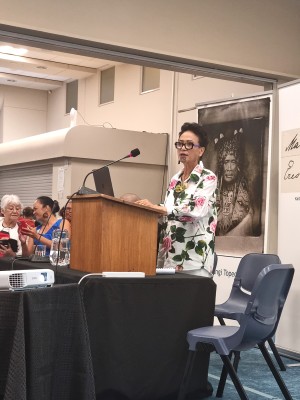
Donna Awatere-Huata giving evidence at Turner Centre, Kerikeri
Rita Beckmannflay
Rita Beckmannflay presented unique evidence about the role of puhi ariki in the tikanga of Ngāti Torehina ki Mataure O Hau.
Te Reo Māori on Legal Tender (Wai 2493) claim
Hearing two, Tūrangawaewae Marae, Ngāruawāhia, February 2021
Read Rita Beckmannflay's evidence (document A28(a))(external link)
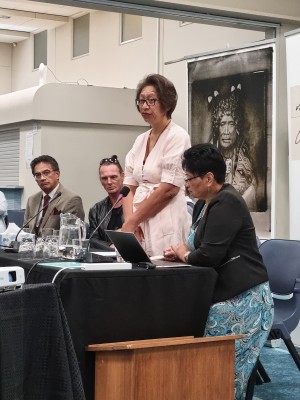
Rita Beckmannflay giving evidence at Turner Centre, Kerikeri
Hinerangi Cooper-Puru
Hinerangi Cooper-Puru is a descendant of Te Wai Ariki, Ngāti Manawa, and Ngāti Kaitutae whakapapa. Her evidence explained how atua whāea influence the relationships between tāne and wāhine, using examples from the life experiences of her mother Dame Whina Cooper.
The Mana Wahine (Cooper-Puru) (Wai 2933) claim
Hearing one, Turner Centre, Kerikeri, February 2021
Read Hinerangi Cooper-Puru's evidence (document A27)(external link)
Lee Harris
Lee Harris’s evidence focused on examples of wahine toa in pūrākau, specifically the wāhine associated with Maui such as Taranga, Murirangawhenua, and Mahuika
The Mana Wahine (Cooper-Puru) (Wai 2933) claim
Hearing one, Turner Centre, Kerikeri, February 2021
Read Lee Harris's evidence (document A23)
Dr Ani Mikaere
Dr Ani Mikaere (Ngāti Raukawa, Ngāti Porou) is a lawyer and academic whose work includes Colonising Myths – Māori Realities: He Rukuruku Whakaaro (2011)(external link) and The Balance Destroyed: The Consequences for Māori Women of the Colonisation of Tikanga Māori (2017)(external link). Her wide-ranging evidence covered the significance of wāhine in Māori theories of creation and how that impacted the status of women in pre-colonial Māori life.
The Mana Wāhine (Pihama and others) (Wai 2872) claim
Hearing one, Turner Centre, Kerikeri, February 2021
Read Dr Ani Mikaere's evidence (document A17)(external link)
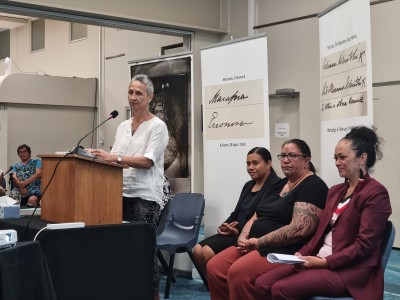
Dr Ani Mikaere giving evidence at Turner Centre, Kerikeri
Professor Leonie Pihama
Professor Leonie Pihama (Te Ātiawa, Waikato-Tainui, Ngā Māhanga a Tairi) is a leading academic who has worked with a wide range of academic and iwi organisations on kaupapa Māori research. Professor Pihama’s first brief of evidence (doc A19) dealt primarily with how ‘Mana Wāhine’ can serve as an indigenous women’s theory, to unpick how colonial notions of gender, race, and class have intersected to silence indigenous knowledges. In a second brief of evidence (doc A148), Professor Pihama detailed Māori understandings of sexuality and gender.
The Mana Wāhine (Pihama and others) (Wai 2872) claim
Hearing one, Turner Centre, Kerikeri, February 2021 and Hearing six, Ngā Hau E Whā, Christchurch, September 2022
Read Professor Leonie Pihama's evidence (document A19)(external link)
Read Professor Leonie Pihama's evidence (document A148)(external link)
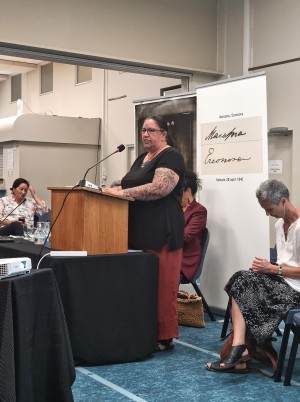
Professor Leonie Pihama giving evidence at Turner Centre, Kerikeri
Mereana Pitman
Mereana Pitman MNZM (Ngāti Kahungunu, Ngāi Tāmanuhiri, Ngāti Wai, Ngāti Porou) is a Tiriti and decolonisation activist, and family violence prevention trainer and facilitator. Her evidence focused on how sexual violence and the doctrine of discovery were used as tools of colonisation that diminished the status of Māori women in Aotearoa.
The Mana Wāhine (Pihama and others) (Wai 2872) claim
Hearing one, Turner Centre, Kerikeri, February 2021
Read Mereana Pitman's evidence (document A18)(external link)
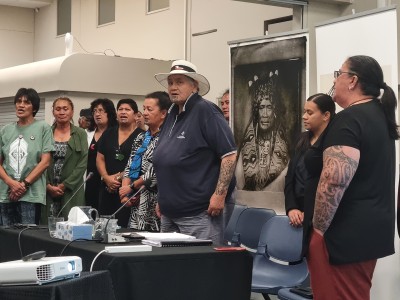
Mereana Pitman with whānau at Turner Centre, Kerikeri
Ani Taniwha
Ani Taniwha is a kuia living in Te Tai Tokerau. A holder of customary knowledge through her whakapapa, Ms Taniwha discussed prominent wāhine toa from the Whangaroa rohe, giving examples of the mana they held over land.
Ngati Hone, Ngati Kawau, Ngati Kawhiti and Nga Uri o Te Pona (Taniwha) (Wai 1666) claim
Hearing one, Turner Centre, Kerikeri, February 2021
Read Ani Taniwha's evidence (document A12)(external link)
Deirdre Nehua
Ngāpuhi kuia Deirdre Nehua gave evidence based on the kōrero her grandmother passed on to her while growing up. She described links between the atua whāea and the rangatiratanga and mātauranga of wāhine Māori in Māori life before colonisation.
Whanau and Hapu of Te Tai Tokerau Settlement Issues (Nehua) (Wai 1837) claim
Hearing one, Turner Centre, Kerikeri, February 2021
Read Deirdre Nehua's evidence (document A25)(external link)
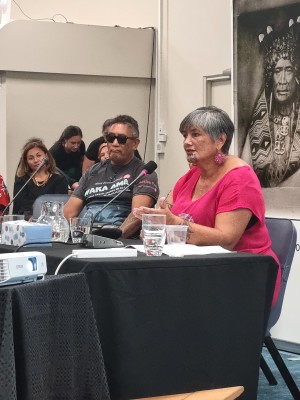
Deirdre Nehua presenting evidence at Turner Centre, Kerikeri
Tina Latimer
Tina Latimer (Ngāti Wai, Whakatōhea, Ngāti Kahu) is the daughter of prominent Māori advocates Sir Graham and Lady Emily Latimer. Her evidence discussed wāhine rangatiratanga, including the contributions of her mother Lady Emily to Māori communities and organisations in Te Tai Tokerau and nationwide.
The Mana Wahine (Durie) (Wai 2925) claim
Hearing one, Turner Centre, Kerikeri, February 2021
Read Tina Latimer's evidence (document A13)(external link)
Ellamein Emery
Raised as whāngai, Ellamein Emery has cared for around 40 whāngai children throughout her life. Her evidence discussed the tikanga of whāngai, which she described as a collective caring and nurturing of children in a Māori way – a practice with both spiritual and physical dimensions.
The Mana Wahine (Durie) (Wai 2925) claim
Hearing one, Turner Centre, Kerikeri, February 2021
Read Ellamein Emery's evidence (document A15)(external link)
Kaa Kereama
Kaa Kereama (Te Arawa) is a mother and grandmother. Her evidence discussed the division of labour between men and women in Māori life before colonisation.
The Mana Wahine (Durie) (Wai 2925) claim
Hearing one, Turner Centre, Kerikeri, February 2021
Read Kaa Kereama's evidence (document A14)(external link)
Tania Rangiheuea
Tania Rangiheuea (Te Arawa, Ngāti Awa, Ngāti Raukawa, Ngāti Manu) is the principal of Waatea School in Mangere and a member of several boards including the Council of Te Whare Wānanga o Awanuiārangi. Having published widely on Māori women’s issues, Tania’s evidence discussed the concept of ‘mana wāhine’ and told the Tribunal about her tūpuna, Te Rangitopeora.
Te Tai Tokerau Mana Wahine (Reid & Evans) (Wai 2260) claim
Hearing one, Turner Centre, Kerikeri, February 2021
Read Tania Rangiheuea's evidence (document A22)(external link)
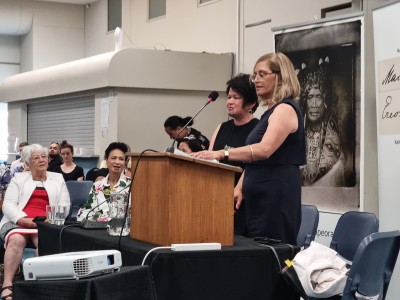
Tania Rangiheuea presenting evidence at Turner Centre, Kerikeri
Te Ringahuia Hata
Te Ringahuia Hata (Te Whakatōhea, Te Whanau a Apanui, Ngāti Tuwharetoa, Ngāi Tūhoe) is a descendant of Muriwai, who she discussed in her wide-ranging evidence. She also explained how the mana of wāhine derives from atua and whakapapa. Her older sister is Robyn Hata-Gage, who also gave evidence.
The Mana Wāhine (Pihama and others) (Wai 2872) claim
Hearing one, Turner Centre, Kerikeri, February 2021
Read Te Ringahuia Hata's evidence (document A30(b))(external link)
Te Ringahuia Hata giving evidence at Turner Centre, Kerikeri
Hearing two
Ngatai Huata
Ngatai Huata (Ngāti Kahungunu) is an accomplished composer, singer-songwriter, and author. Her evidence focused on the oral and traditional knowledge of wāhine in the pre-1800s, including waiata.
The Mana Wāhine (Ngāti Kahungunu) (Wai 2820) claim
Hearing two, Tūrangawaewae Marae, Ngāruawāhia, February 2021
Read Ngatai Huata's evidence (document A54)(external link)
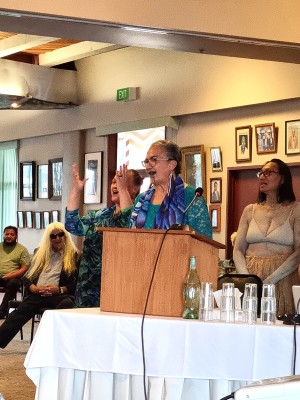
Ngatai Huata giving evidence at Tūrangawaewae Marae, Ngāruawāhia
Paula Ormsby
Paula Ormsby is the leader in the Wāhine Toa chapter of the Mongrel Mob Kingdom. Her evidence discussed the inherent mana of wāhine Māori, referring to atua wāhine within Māori cosmology, and her own whakapapa.
The Mana Wahine (Ormsby and Kurarangi) (Wai 3011) claim
Hearing two, Tūrangawaewae Marae, Ngāruawāhia, February 2021
Read Paula Ormsby's evidence (document A55)(external link)
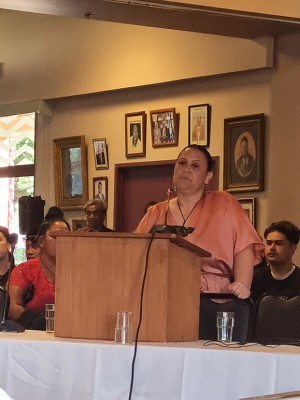
Paula Ormsby giving evidence at Tūrangawaewae Marae, Ngāruawāhia
Te Motoi Taputu
The evidence of Te Motoi Taputu (Ngāti Makino, Ngāti Whakahemo, Ngai Tūhoe) focused on creation stories, atua, and the balance between men and women. She gave examples of important wāhine, including warriors and wāhine rangatira.
The Racism Against Māori (Wai 2494) claim
Hearing two, Tūrangawaewae Marae, Ngāruawāhia, February 2021
Read Te Motoi Taputu's evidence (document A50)(external link)
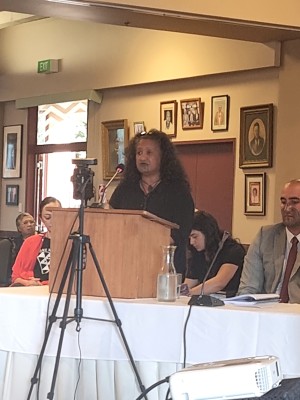
Te Motoi Taputu giving evidence at Tūrangawaewae Marae, Ngāruawāhia
Mamae Takerei
Mamae Takerei was the mana reo for Tūrangawaewae Marae during hearing two. Her evidence was drawn from her thesis ‘Tūrangawaewae mo Te Kiingitanga’ (University of Waikato, 2019). It focused on the influence of Te Puea Hērangi, as well as the history of the Kingitanga.
The Mana Wāhine (Pihama and others) (Wai 2872) claim
Hearing two, Tūrangawaewae Marae, Ngāruawāhia, February 2021
Read Mamae Takerei's evidence (document A32)(external link)
Te Kahautu Maxwell
Te Kahautu Maxwell (Te Whakatōhea, Ngāti Awa, Ngāi Tai, Te Whānau a Apanui, Ngāti Porou, Ngāti Maniapoto, Tūhoe) is a Ringatū tohunga and an academic at the University of Waikato. His evidence focused on prominent wāhine in his life and whakapapa.
The Mana Wāhine (Pihama and others) (Wai 2872) claim
Hearing two, Tūrangawaewae Marae, Ngāruawāhia, February 2021
Read Te Kahautu Maxwell's evidence (document A46)(external link)
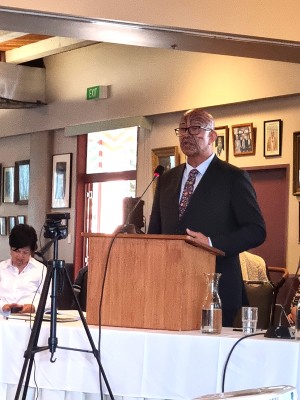
Te Kahautu Maxwell giving evidence at Tūrangawaewae Marae, Ngāruawāhia
Robyn Hata-Gage
Robyn Hata-Gage (Ngāti Ira, Whakatōhea, Ngāti Ruatakenga) gave evidence about three wāhine rangatira in her whakapapa: Muriwai, her maternal grandmother Rawinia Rangitakatu (nee Wehi), and her mother Te Aroha Hata. Her younger sister is Te Ringahuia Hata, who also gave evidence.
Ngāti Ira o Waiōweka Rohe (Wai 558) claim
Hearing two, Tūrangawaewae Marae, Ngāruawāhia, February 2021
Read Robyn Hata-Gage's evidence (document A33)(external link)
Barbara Moke
Barbara Moke gave evidence as a representative of Te Whakaruruhau (Waikato Women’s Refuge). She explained how Te Whakaruruhau’s mahi is informed by the traditional roles of Māori women as weavers and the importance of te whare tangata.
Maori Women’s Refuge (Simpson and Albert) (Wai 1885) claim
Hearing two, Tūrangawaewae Marae, Ngāruawāhia, February 2021
Read Barbara Moke's evidence (document A38)(external link)
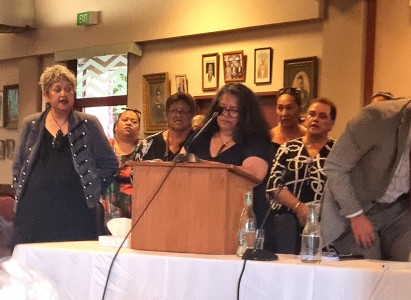
Barbara Moke giving evidence at Tūrangawaewae Marae, Ngāruawāhia
Sharon Campbell and Dr Mania Campbell-Seymour
Mother and daughter Sharon Campbell and Dr Mania Campbell-Seymour (Te Whakatōhea, Ngāti Rua) gave a wide-ranging joint brief of evidence that drew on a thesis published by Hinehou Campbell (Sharon’s mother and Mania’s grandmother) about the significance of Māori women in Māori life before colonisation, based on treasured knowledge passed intergenerationally in their whānau and Te Whakatōhea. They also discussed raupatu, Tiriti activism, and experiences revitalising mātauranga and reo Māori within their whānau.
The Mental Health Services (Campbell) (Wai 2728) claim
Hearing two, Tūrangawaewae Marae, Ngāruawāhia, February 2021
Sharon Campbell and Dr Mania Campbell-Seymour's evidence (document A39(external link) and document A39(a)(external link))
Hinewīrangi Morgan
Hinewīrangi Morgan (Ngāti Kahungunu, Raikaipaka) shared a poem and a song she wrote about the mana wāhine flowing throughout generations, entitled ‘Five Kuia/Grandmothers ago.’
Te Rūnanga o Kirikiriroa (Wai 2807) claim
Hearing two, Tūrangawaewae Marae, Ngāruawāhia, February 2021
Read Hinewīrangi Morgan's evidence (document A40)(external link)
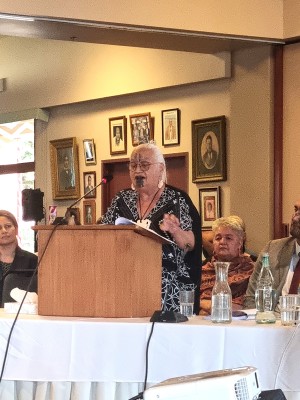
Hinewīrangi Morgan giving evidence at Tūrangawaewae Marae, Ngāruawāhia
Kerri Nuku
Kerri Nuku (Ngāti Kahungunu, Ngāi Tai) is Kaiwhakahaere for the Tōpūtanga Tapuhi Kaitiaki o Aotearoa, New Zealand Nurses Organisation (the largest trade union and professional organisation representing New Zealand’s nursing professions). Ms Nuku’s evidence focused on the history of nursing in Aotearoa and the challenges faced by wāhine Māori nurses.
The Māori Nurses (Wai 2713) claim
Hearing two, Tūrangawaewae Marae, Ngāruawāhia, February 2021
Read Kerri Nuku's evidence (document A41)(external link)
Tracy Haddon
Tracy Haddon (Ngāpuhi), a registered nurse, told the Tribunal about the history of mainstream nursing in New Zealand and its implementation at the expense of mātauranga Māori.
The Māori Nurses (Wai 2713) claim
Hearing two, Tūrangawaewae Marae, Ngāruawāhia, February 2021
Read Tracy Haddon's evidence (document A42)(external link)
Naomi Waipouri
Naomi Waipouri (Te Rarawa, Ngāti Whātua), a registered nurse, discussed the challenges she has experienced implementing mātauranga and tikanga in her nursing career.
The Māori Nurses (Wai 2713) claim
Hearing two, Tūrangawaewae Marae, Ngāruawāhia, February 2021
Read Naomi Waipouri's evidence (document A43)(external link)
Moana Teiho
Moana Teiho (Te Rarawa) has experience as a nurse and a healer with skills in rongoā, mirimiri, and matakite. She discussed the features and importance of Māori health practices and models.
The Māori Nurses (Wai 2713) claim
Hearing two, Tūrangawaewae Marae, Ngāruawāhia, February 2021
Read Moana Teiho's evidence (document A44)
Sandra Corbett
Sandra Corbett (Te Arawa, Ngāti Pikiao) is a Kaiwhakahaere in the Hawke’s Bay National Cervical Screening Programme and has served on several national health advisory groups. She discussed how te whare tangata relates to cervical screening in Aotearoa.
The Māori Nurses (Wai 2713) claim
Hearing two, Tūrangawaewae Marae, Ngāruawāhia, February 2021
Read Sandra Corbett's evidence (document A45)(external link)
Dr Aroha Yates-Smith
Dr Aroha Yates-Smith is a distinguished kuia, academic, and composer, affiliated to the Te Arawa, Tainui, Tākitimu, Horouta, and Mātaatua waka. Drawing on her 1980 Masters’ thesis titled ‘Ko te Wharepora o Hine-te-iwaiwa: he titiro ki ētahi āhuatanga o ngā kākahu o te iwi Māori’, her evidence focused on the art of weaving traditional Māori cloaks and referenced atua wāhine relating to weaving.
The Racism Against Māori (Wai 2494) claim
Hearing two, Tūrangawaewae Marae, Ngāruawāhia, February 2021
Read Dr Aroha Yates-Smith's evidence (document A47)(external link)
Dickie Farrar
Dickie Farrar is a registered nurse of Te Whānau-a-Apanui, Ngāti Porou, Te Aitanga-a-Hauiti, Ngāti Pahauwera, and Whakatōhea descent. Her evidence discussed her tūpuna Akenehi Hei, one of the first Māori nurses.
The Māori Nurses (Wai 2713) claim
Hearing two, Tūrangawaewae Marae, Ngāruawāhia, February 2021
Read Dickie Farrar's evidence (document A48)(external link)
Sharryn Te Atawhai Barton
Sharryn Te Atawhai Barton (Waikato, Ngāti Raukawa, Ngāti Maniapoto) is the Rūnanga Convenor for E tū union, an elected representative on the rūnanga of the New Zealand Council of Trade Unions. Her evidence discussed the influence of Te Puea Hērangi.
The Mana Wahine (Barnett) (Wai 2859) claim
Hearing two, Tūrangawaewae Marae, Ngāruawāhia, February 2021
Read Sharryn Te Atawhai Barton (document A49)(external link)
Te Amohia McQueen
Te Amohia McQueen (Ngāti Rōrā, Waikato-Maniapoto, Ngāti Porou) is a whānau advocate and a descendant of Te Wherowhero Tāwhiao, the second born son of Tāwhiao and the grandson of Pōtatau Te Wherowhero. Her evidence focused on how mana wāhine derives from the atua.
Descendants of Io Matua Kore (McQueen) (Wai 2118) claim
Hearing two, Tūrangawaewae Marae, Ngāruawāhia, February 2021
Read Te Amohia McQueen's evidence (document A52)(external link)
Cletus Maanu Paul
Cletus Maanu Paul (Ngāti Manawa, Ngāi Tūhoe, Ngāti Awa, Tainui) was a kaumātua and long-standing member of the New Zealand Māori Council. His evidence covered the significance of mythology; wāhine roles in te ao Māori before colonisation; wāhine Māori and the signing of te Tiriti; and, the impact of colonisation on mana wāhine.
The Mana Wāhine (Paul and others) (Wai 2846) claim
Hearing two, Tūrangawaewae Marae, Ngāruawāhia, February 2021
Read Cletus Maanu Paul's evidence (document A51)(external link)
Anne Rotorangi-Kendall
Anne Rotorangi-Kendall QSM has been an active volunteer in Māori and community organisations for most of her life, including Papakura Marae and the Māori Wardens. Her evidence discussed the voluntary work of wāhine Māori in contemporary Aotearoa.
The Mana Wahine (Durie) (Wai 2925) claim
Hearing two, Tūrangawaewae Marae, Ngāruawāhia, February 2021
Read Anne Rotorangi-Kendall's evidence (document A36)(external link)
Pastor Pauline Rewiti
Pastor Pauline Rewiti (Waikato-Maniapoto) is a kuia, a voluntary social worker, and former pastor for the Māori Queen. Her evidence emphasised the need for wāhine Māori voluntary work to be recognised and compensated.
The Mana Wahine (Durie) (Wai 2925) claim
Hearing two, Tūrangawaewae Marae, Ngāruawāhia, February 2021
Pastor Pauline Rewiti (document A34)(external link)
Sheena Ross
Sheena Ross shared kōrero passed down from her elders about the mana of wāhine, and reflected on her own ‘trials and tribulations’ as a wahine of Ngati KoroKoro.
The Sexual Abuse of Māori Wāhine and Tamariki (Wai 2673) claim
Hearing two, Tūrangawaewae Marae, Ngāruawāhia, February 2021
Read Sheena Ross's evidence (document A56(a))(external link)
Waina Hoete Ahipene and Grace Hoet
Grace Hoet (Te Aupouri Ngāti Kuri, Te Rarawa Ngāti Manawa, Ngā Puhi Ngāti Hau, Te Arawa Waka, Ngāti Wahiao, Tuhourangi, Ngāti Rangiwewehi, Ngāti Pikiao, Ngāti Whakaue, Ngāti Tuwharetoa Ngāti Hikairo, Ngāti Kahungunu, Ngāti Hinemanu, Ngāti Paki, Ngāti Raukawa) is an actress and producer. Her evidence focused on the life and beliefs of her nanny, Waina Hoete Ahipene, who is 100 years of age and has five generations of descendants, including 350 mokopuna.
The Mana Wahine (Durie) (Wai 2925) claim
Hearing two, Tūrangawaewae Marae, Ngāruawāhia, February 2021
Read Waina Hoete Ahipene and Grace Hoet's evidence (document A37)(external link)
Hearing three
Materangatira Lily Porter
Materangatira Lily Porter (born 1936) is a kuia from Tūhoe, with connections to Te Whakatōhea, Te Arawa, Waikato-Tainui, and Te Whānau a Apanui. Drawing on kōrero tuku iho she learned while being raised by her grandparents, her evidence traversed topics including whakapapa, atua, whakapapa, roles of tāne and wāhine, whānau, tikanga, and whenua.
Tutamoe Pa (Wai 1968) claim
Hearing three, Terenga Parāoa Marae, Whangārei, July 2021
Read Materangatira Lily Porter's evidence (document A16(a))(external link)
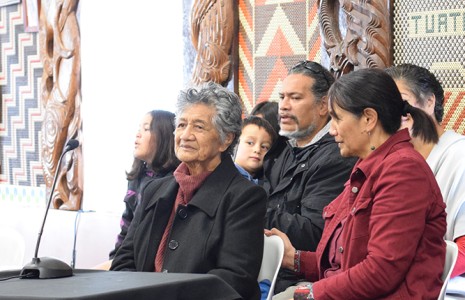
Materangatira Lily Porter giving evidence at Terenga Parāoa Marae, Whangārei, pictured with whānau
Jessica Williams
Jessica Williams (Ngaitūpango, Ngāpuhi) is a kaiako with 20 years’ experience in education. Her evidence was about mau rākau and discussed atua wāhine Hine Keira and Hine Akaaka.
The Mana Wāhine (Williams) (Wai 2838) claim
Hearing three, Terenga Parāoa Marae, Whangārei, July 2021
Read Jessica Williams's evidence (document A61)(external link)
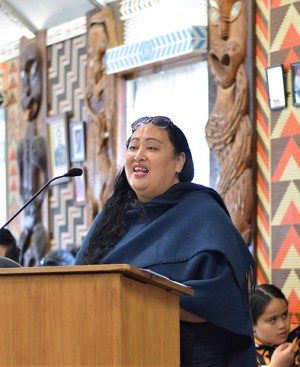
Jessica Williams giving evidence at Terenga Parāoa Marae, Whangārei
Bryce Peda-Smith
Bryce Peda-Smith (Ngāti Pakahi, Ngāpuhi) is a pāpā and grandfather who gave evidence alongside his partner Violet Walker and whanaunga Robyn York. He talked about his tūpuna who exemplify mana wāhine, including Tuhi Kura and Turikatuku.
The Ngāti Pakahi (Aldridge) (Wai 2377) claim
Hearing three, Terenga Parāoa Marae, Whangārei, July 2021
Read Bryce Peda-Smith's evidence (document A64)(external link)
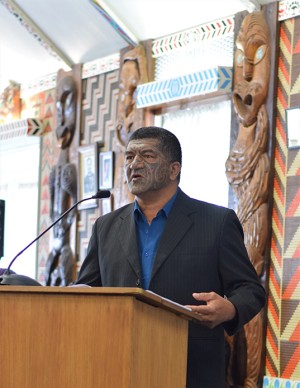
Bryce Peda-Smith giving evidence at Terenga Parāoa Marae, Whangārei
Robyn York
Robyn York (Ngāti Pakahi, Ngāpuhi) gave evidence alongside whanaunga Violet Walker and Bryce Peda-Smith. Her evidence focused on atua wāhine, the traditional roles of wāhine as tohunga and kaitiaki, and key concepts in relation to mana wāhine (including mana, tapu, whakamā, utu and the restoration of noa). She also discussed whānau, whāngai, and birthing.
The Ngāti Pakahi (Aldridge) (Wai 2377) claim
Hearing three, Terenga Parāoa Marae, Whangārei, July 2021
Read Robyn York's evidence (document A65)(external link)
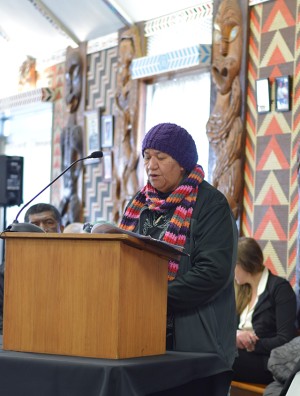
Robyn York giving evidence at Terenga Parāoa Marae, Whangārei
Violet Walker
Violet Walker (Ngati Rangi, Ngati Porou) is a māmā and grandmother who gave evidence alongside her partner Bryce Peda-Smith and whanaunga Robyn York. Her evidence discussed roles and responsibilities of wāhine, and the maintenance of balance between wāhine and tāne – all illustrated with examples of practices related to birth and pregnancy, weaving, and the restoration of noa.
The Ngāti Pakahi (Aldridge) (Wai 2377) claim
The Tahawai (Aldridge) (Wai 2382) claim
Hearing three, Terenga Parāoa Marae, Whangārei, July 2021
Read Violet Walker's evidence (document A66)(external link)
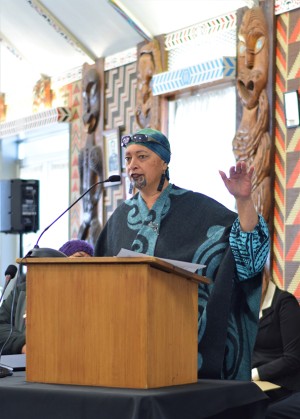
Violet Walker giving evidence at Terenga Parāoa Marae, Whangārei
Aorangi Kawiti
Aorangi Kawiti is a Ngāpuhi kuia and an uri of Kawiti, who was a rangatira and signatory of te Tiriti. Her evidence described how mana wāhine was expressed before colonisation, including through leadership and whakapapa, and through karanga and waiata.
Opua Lands and Waterways (Wai 120) claim
Hearing three, Terenga Parāoa Marae, Whangārei, July 2021
Read Aorangi Kawiti's evidence (document A24(a))(external link)
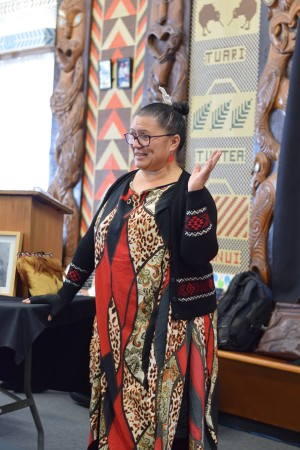
Aorangi Kawiti giving evidence at Terenga Parāoa Marae, Whangārei
Louisa Collier
Louisa Collier is a Ngāpuhi kuia who was born in Rangiahua and lives in Whangārei. Her evidence focused on the pivotal role of puhi (a ceremonial role played by high-born wāhine who held mana whenua) in Ngāpuhi whakapapa, and discussed two of her tūpuna who were puhi; Hinewhare and Kaiwhare.
Ngati Kawau (Taniwha, Collier and Dargaville) (Wai 1673) claim
Descendants of Hinewhare (Wai 1541) claim
Descendants of Ngatau Tangihia (Wai 1917) claim
Hearing three, Terenga Parāoa Marae, Whangārei, July 2021
Read Louisa Collier's evidence (document A26)(external link)
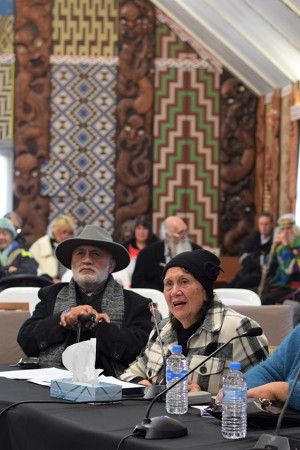
Louisa Collier giving evidence at Terenga Parāoa Marae, Whangārei
Jane Ruka and Te Miringa Huriwai
Jane Ruka and Te Miringa Huriwai presented evidence on behalf of the Waitaha Grandmother Council about Māori spirituality, female atua, and the roles played by wāhine in Aotearoa before colonisation.
Waitaha (Te Korako and Harawira) (Wai 1940) claim
Hearing three, Terenga Parāoa Marae, Whangārei, July 2021
Read Jane Ruka and Te Miringa Huriwai's evidence (document A53(a))(external link)
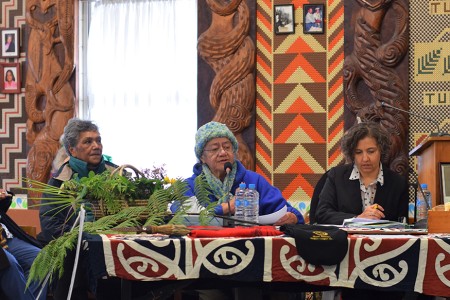
Jane Ruka (left) and Te Miringa Huriwai (right) giving evidence at Terenga Parāoa Marae, Whangārei
Awhirangi Lawrence
Awhirangi Lawrence gave evidence on how whenua within the Whangaroa rohe was passed down through tūpuna whaea, a practice that was disrupted by colonisation.
Ngati Kawau (Taniwha, Collier and Dargaville) (Wai 1673) claim
Descendants of Hinewhare (Wai 1541) claim
Hearing three, Terenga Parāoa Marae, Whangārei, July 2021
Read Awhirangi Lawrence's evidence (document A58)(external link)
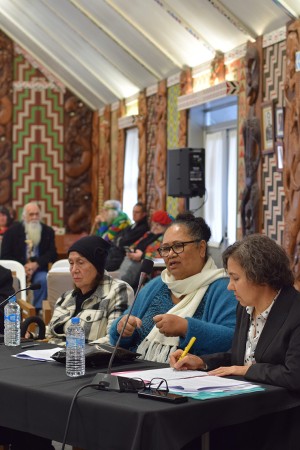
Awhirangi Lawrence giving evidence at Terenga Parāoa Marae, Whangārei
Titewhai Harawira
Titewhai Harawira (Ngāpuhi) was a kuia and staunch advocate for the rights of tangata whenua and Māori women. Her evidence focused on the roles played by wāhine in te ao Māori pre-1840, as leaders, rangatira, and kaitiaki of the whenua.
Ngapuhi Kuia & Kaumatua (Wai 1427) claim
Hearing three, Terenga Parāoa Marae, Whangārei, July 2021
Read Titewhai Harawira's evidence (document A68)(external link)
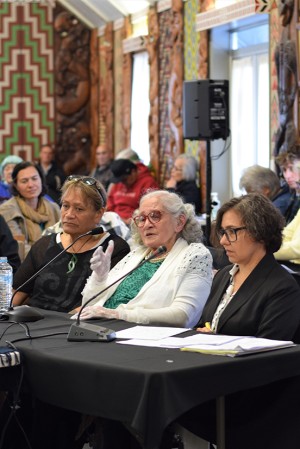
Titewhai Harawira giving evidence at Terenga Parāoa Marae, Whangārei
Hūhana Lyndon and Nicki Wakefield
Hūhana Lyndon and Nicki Wakefield (Ngāti Hine, Ngāpuhi, Ngatiwai, Ngāti Whatua) gave evidence on how whenua in the Whangārei rohe is derived through female whakapapa.
The Mana Wahine (Lyndon) (Wai 2917) claim
Hearing three, Terenga Parāoa Marae, Whangārei, July 2021
Read Hūhana Lyndon and Nicki Wakefield's evidence (document A59)(external link)
Patricia Tauroa
Patricia Tauroa is a kuia who gave evidence on behalf of Ngā Hapū o Whangaroa. Her evidence shared her personal reflections and kōrero tuku iho related to the four themes of Te Arataki: atua and tūpuna whaea; the balance between tāne and wāhine; the mana of wāhine in society; and, wāhine rangatiratanga over whenua, whakapapa and whānau, whai rawa, and mātauranga.
Whangaroa Lands and Fisheries (Wai 58) claim
Hearing three, Terenga Parāoa Marae, Whangārei, July 2021
Read Patricia Tauroa's evidence (document A60)(external link)
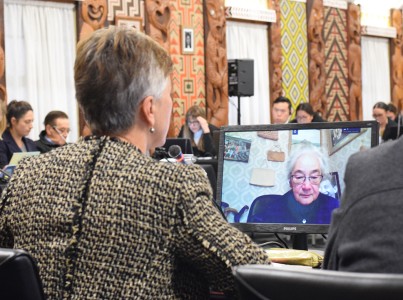
Patricia Tauroa giving evidence virtually, pictured with Judge Sarah Reeves
Moe Milne
Moe Milne (Ngāti Hine) is a practitioner across the health, education and social services sectors and is recognised as a te reo Māori advocate and expert. Her evidence focused on her tūpuna, Hine-ā-Maru; her first-born son Whē; and her descendant Kawiti, who signed te Tiriti. She was a support worker in the original team who filed the The Māori Women’s (Wai 381) claim in 1993.
Ngati Hine Lands, Forests and Resources (Wai 682) claim
Hearing three, Terenga Parāoa Marae, Whangārei, July 2021
Read Moe Milne's evidence (document A62)(external link)
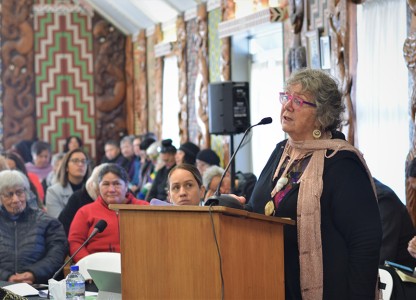
Moe Milne giving evidence at Terenga Parāoa Marae, Whangārei
Dr Ella Henry
Dr Ella Henry (Ngati Aukiwa, Ngātikahu ki Whangaroa, urban Māori) is an Associate Professor and the Director of Māori Advancement for the Business School at the Auckland University of Technology. Her evidence was based on her Masters thesis and covered pre-colonial Māori life, including women’s status and roles in public, political, economic, and social affairs; gender complementarity; Māori cosmology; and values, traditions, and practices relating to social relations, sexuality, marriage, procreation, family, divisions of labour and warfare.
The Māori Women’s (Wai 381) claim
Hearing three, Terenga Parāoa Marae, Whangārei, July 2021
Read Dr Ella Henry's evidence (document A63)(external link)
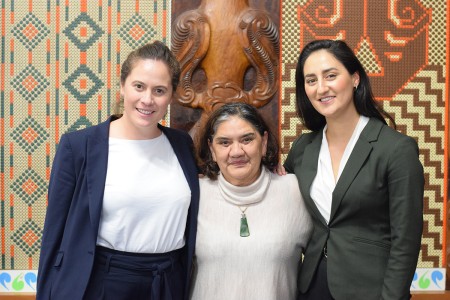
Dr Ella Henry pictured with lawyers Natalie Coates (left) and Tara Hauraki (right)
Dr Ngahuia Murphy
Dr Ngahuia Murphy (Tūhoe, Ngāti Manawa, Ngāti Ruapani ki Waikaremoana, Ngāti Kahungunu) is a researcher and writer. A Health Research Council post-doctoral fellow, her research seeks to uncover pre-colonial Māori language and knowledge related to Māori women’s reproductive bodies. Her evidence focused on te whare tangata, its spiritual significance, its centrality to the mana of wāhine, and rituals and practices associated with women’s bodies in traditional Māori society.
The Mana Wāhine (Pihama and others) (Wai 2872) claim
Hearing three, Terenga Parāoa Marae, Whangārei, July 2021
Read Dr Ngahuia Murphy's evidence (document A67)(external link)
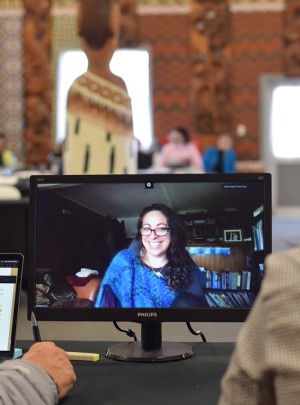
Dr Ngahuia Murphy giving evidence virtually
Ipu Tito-Absolum
Ipu Tito-Absolum’s (Ngāpuhi) evidence focused on mana wāhine in relation to the cosmos, and recounted stories of her tūpuna Maraea Te-Kuri-o-te-Wao Paehangi and her descendants.
The Mana Wāhine (Pihama and others) (Wai 2872) claim
Hearing three, Terenga Parāoa Marae, Whangārei, July 2021
Read Ipu Tito-Absolum's evidence (document A70)(external link)
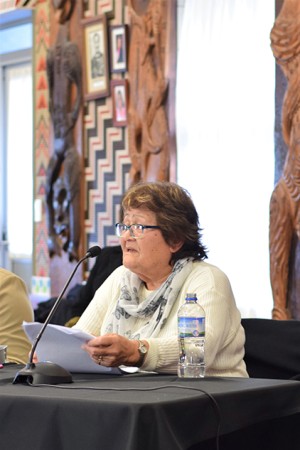
Ipu Tito-Absolum giving evidence at Terenga Parāoa Marae, Whangārei
Heeni Hoterene
Heeni Hoterene (Ngāti Hine, Ngāti Pare, Kohatutaka, Ngāpuhi) is an educator and practitioner of the māramataka (Māori lunar calendar). Her evidence included kōrero on the mana and rangatiratanga exercised by two tūpuna, Maikuku and Hineamaru, and provided insight on wāhine and the māramataka.
The Mana Wāhine (Pihama and others) (Wai 2872) claim
Hearing three, Terenga Parāoa Marae, Whangārei, July 2021
Read Heeni Hoterene's evidence (document A75)(external link)
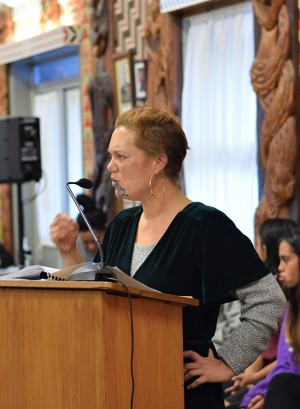
Heeni Hoterene giving evidence at Terenga Parāoa Marae, Whangārei
Hilda Halkyard-Harawira
Hilda Halkyard-Harawira (Ngāti Haua ki Te Rarawa, Ngāti Whātua, Te Aupouri me Te Moana Nui a Kiwa) is an activist and a pioneer of kura kaupapa. Her evidence focused on Māori education, including kura kaupapa, and the revitalisation of te reo Māori – particularly the role of wāhine in these movements.
The Mana Wāhine (Pihama and others) (Wai 2872) claim
Hearing three, Terenga Parāoa Marae, Whangārei, July 2021
Read Hilda Halkyard-Harawira's evidence (document A79)(external link)
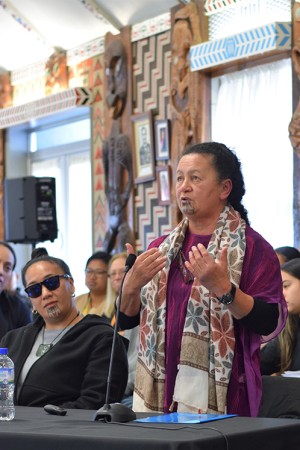
Hilda Halkyard-Harawira giving evidence at Terenga Parāoa Marae, Whangārei
Hana Maxwell
Hana Maxwell (Ngātihau) is a Ngāpuhi kuia who gave evidence about atua wāhine, tikanga, and several of her Ngātihau tūpuna.
The Mana Wāhine (Maxwell) (Wai 2855) claim
Hearing three, Terenga Parāoa Marae, Whangārei, July 2021
Read Hana Maxwell's evidence (document A69)(external link)
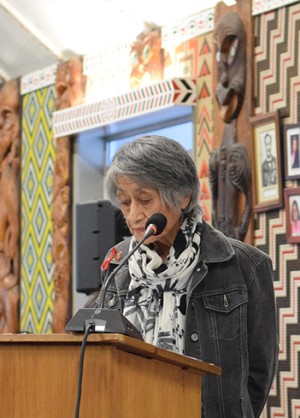
Hana Maxwell giving evidence at Terenga Parāoa Marae, Whangārei
Rereata Makiha
Rereata Makiha (Te Mahurehure, Te Aupōuri, Te Arawa) is a Māori astronomer and leading authority on the māramataka (Māori lunar calendar). His evidence outlined the roles of wāhine as navigators, keepers of traditional knowledge through whare wānanga, and gardeners in pre-colonial Māori life.
Te Tai Tokerau Mana Wahine (Reid & Evans) (Wai 2260) claim
Hearing three, Terenga Parāoa Marae, Whangārei, July 2021
Read Rereata Makiha's evidence (document A71)(external link)
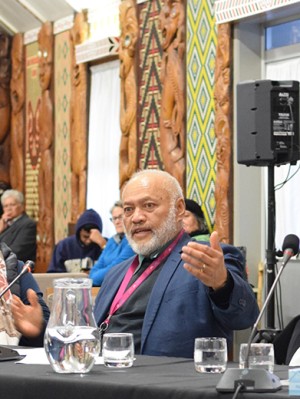
Rereata Makiha giving evidence at Terenga Parāoa Marae, Whangārei
Heeni Brown
Heeni Brown (Te Rarawa) gave evidence that covered whakapapa, atua, the balance between wāhine and tāne, tikanga, and mātauranga.
The Mana Wahine (Allen) (Wai 3003) claim
Hearing three, Terenga Parāoa Marae, Whangārei, July 2021
Read Heeni Brown's evidence (document A73)(external link)
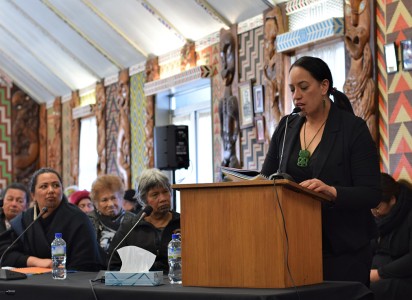
Heeni Brown giving evidence at Terenga Parāoa Marae, Whangārei
Rukuwai Allen
Rukuwai Allen (Ngāti Hine) is a broadcaster and political commentator. She gave evidence discussing the different qualities of wāhine and tāne.
The Mana Wahine (Allen) (Wai 3003) claim
Hearing three, Terenga Parāoa Marae, Whangārei, July 2021
Read Rukuwai Allen's evidence (document A74)(external link)
Materoa Dodd
Materoa Dodd (Ngāti Awa, Ngai Te Rangi) is an iwi development practitioner, hapū and marae trustee, and wānanga and Crown entity board member. Her evidence was about the inherent power, authority, and status of two Ngāti Awa tīpuna, Muriwai and Wairaka, who arrived in Aotearoa on the Mātaatua waka.
Te Tai Tokerau Mana Wahine (Reid & Evans) (Wai 2260) claim
Hearing four, Te Mānuka Tūtahi Marae, Whakatāne, July 2022
Read Materoa Dodd's evidence (document A98)(external link)
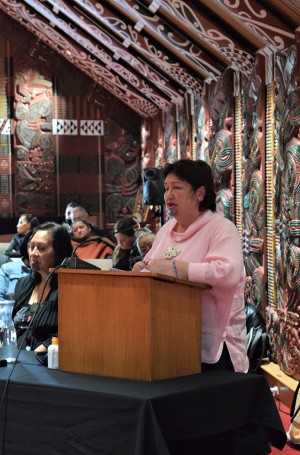
Materoa Dodd giving evidence at Te Mānuka Tūtahi Marae, Whakatāne
Dayle Takitimu
Dayle Takitimu (Te Whānau a Apanui) is a lawyer, researcher, author, and mother. Her evidence was about reclaiming the status of mana wāhine in pre-colonial times.
Te Tai Tokerau Mana Wahine (Reid & Evans) (Wai 2260) claim
Hearing four, Te Mānuka Tūtahi Marae, Whakatāne, July 2022
Read Dayle Takitimu's evidence (document A96)(external link)
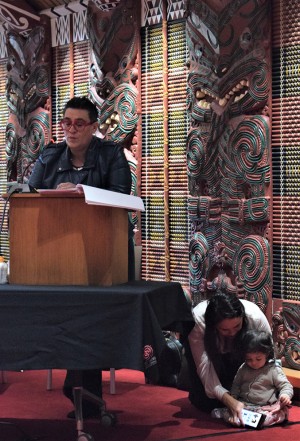
Dayle Takitimu giving evidence at Te Mānuka Tūtahi Marae, Whakatāne, pictured with mokopuna (right)
Waitangi Black
The evidence of Waitangi Black (Ngai Tūhoe, Ngāti Awa, Te Whakatōhea, Te Whānau a Apanui) focused on the characteristics and lives of her Ngāti Awa kuia, and her mother. She described how they have influenced her own strength and integrity.
The Mana Wāhine (Pihama and others) (Wai 2872) claim
Hearing four, Te Mānuka Tūtahi Marae, Whakatāne, July 2022
Read Waitangi Black's evidence (document A101)(external link)
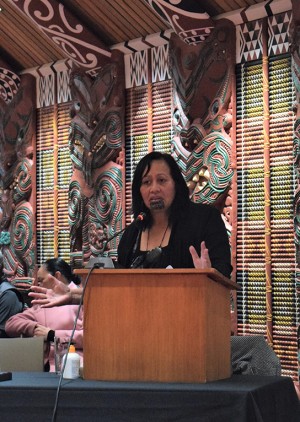
Waitangi Black giving evidence at Te Mānuka Tūtahi Marae, Whakatāne
Te Rangitunoa Black
In her evidence, Te Rangitunoa Black’s (Ngai Tūhoe Pōtiki, Ngāti Tūwharetoa, Te Arawa, Raukawa, Te Whānau a Apanui, Ngai Te Rangi, Ngāti Ruapani, Ngāti Porou, Ngāti Kahungunu, Te Aitanga-ā-Mahaki, Rongowhakaata) detailed the roles and significance of wāhine in te ao Māori and in Māori spirituality, with a particular focus on Hinepūkohurangi (the Mist Maiden).
The Mana Wāhine (Pihama and others) (Wai 2872) claim
Hearing four, Te Mānuka Tūtahi Marae, Whakatāne, July 2022
Read Te Rangitunoa Black's evidence (document A99)(external link)
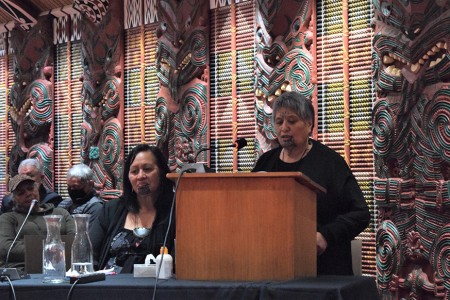
Te Rangitunoa Black giving evidence at Te Mānuka Tūtahi Marae, Whakatāne, pictured with Waitangi Black (left)
Professor Rangi Mātāmua
Professor Rangi Mātāmua (Tūhoe) is a Māori astronomer, Professor of Mātauranga Māori at Massey University, and advised the government about mātauranga related to Matariki. His evidence examined various atua wahine embodied by different astronomical bodies and their influence on the natural and social worlds.
The Mana Wāhine (Pihama and others) (Wai 2872) claim
Hearing four, Te Mānuka Tūtahi Marae, Whakatāne, July 2022
Read Professor Rangi Mātāmua's evidence (document A86)(external link)
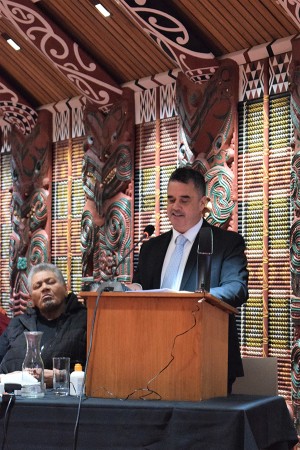
Professor Rangi Mātāmua giving evidence at Te Mānuka Tūtahi Marae, Whakatāne, pictured with Mereana Pitman (left)
Dr Moana Jackson (evidence read by Dr Ani Mikaere)
Dr Moana Jackson (Ngāti Kahungunu, Rongomaiwahine, Ngāti Porou) was a lawyer specialising in constitutional law, te Tiriti o Waitangi and international Indigenous issues, and an advocate for Māori rights. His evidence (read by Ani Mikaere) described the concept of mana wāhine. He stressed that every part of tikanga and mātauranga Māori was based on the equality and interdependence of Māori women and men.
The Mana Wāhine (Pihama and others) (Wai 2872) claim
Hearing four, Te Mānuka Tūtahi Marae, Whakatāne, July 2022
Read Dr Moana Jackson's evidence (document A85)(external link)
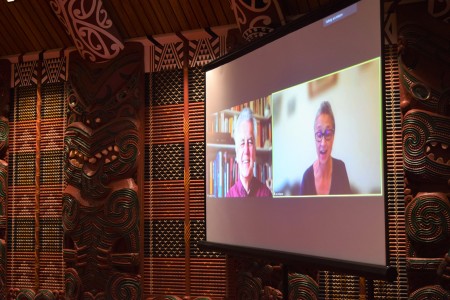
Dr Ani Mikaere reading Dr Moana Jackson's evidence at Te Mānuka Tūtahi Marae, Whakatāne
Tina Ngata
Tina Ngata (Ngāti Porou) is a researcher, educator, and advocate for environmental, Indigenous, and human rights. She is the author of Kia Mau: Resisting Colonial Fictions (2019). Her evidence focused on the status of mana wāhine in Ngāti Porou, particularly in Matakaoa, and the significant role wāhine Māori played pre-1840 as encapsulated through ancestral literary, oratory, and fine arts. She also discussed the impact of the doctrine of discovery on indigenous women.
The Mana Wāhine (Pihama and others) (Wai 2872) claim
Hearing four, Te Mānuka Tūtahi Marae, Whakatāne, July 2022
Read Tina Ngata's evidence (document A88)(external link)
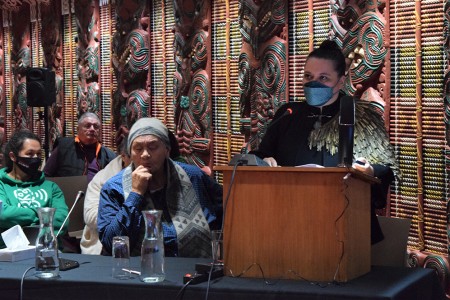
Tina Ngata giving evidence at Te Mānuka Tūtahi Marae, Whakatāne, pictured with Mereana Pitman (left)
Timitepō Hohepa
Timitepō Hohepa’s (Ngāti Pikiao) evidence on mana wāhine drew from mythology and stories of tupuna.
The Mana Wāhine (Pihama and others) (Wai 2872) claim
Hearing four, Te Mānuka Tūtahi Marae, Whakatāne, July 2022
Read Timitepō Hohepa's evidence (document A90)(external link)
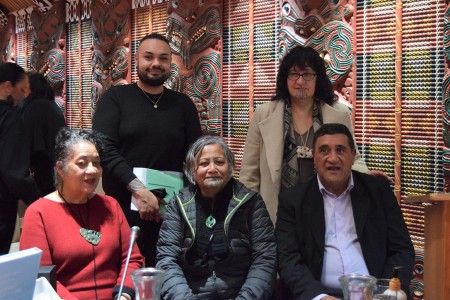
Timitepō Hohepa pictured with Annette Sykes (right) and whānau
Anna Kurei
Anna Kurei (Ngāti Ira) gave evidence about ‘Te Tapu o Muriwai’, which she described as a ‘very old waiata that holds ancient knowledge ... about the rohe moana of Te Whakatōhea’.
Ngāti Ira o Waiōweka Rohe (Wai 558) claim
Hearing four, Te Mānuka Tūtahi Marae, Whakatāne, July 2022
Read Anna Kurei's evidence (document A100)(external link)
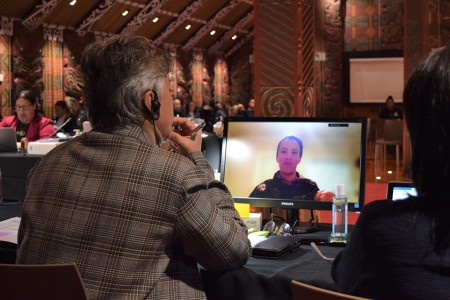
Anna Kurei giving evidence virtually, pictured with Judge Sarah Reeves
Melaina Huaki
Melaina Huaki (Ngāti Awa, Te Whānau a Ruataupare, Te Aitanga o Hauiti, Te Aitanga a Mahaki, Tuwharetoa) is a contractor who delivers kaupapa ora for the Waikato coalition and Te Manatu Hauora. Her evidence focused on Whakaotirangi, the principal wife of Hoturoa, kaihautū of the Tainui Waka.
Te Rūnanga o Kirikiriroa (Wai 2807) claim
Hearing four, Te Mānuka Tūtahi Marae, Whakatāne, July 2022
Read Melaina Huaki's evidence (document A89)(external link)
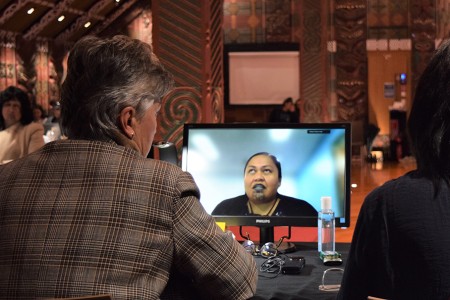
Melaina Huaki giving evidence virtually, pictured with Judge Sarah Reeves
Keita Hudson
Keita Hudson (Whakatōhea) is a trustee on both the Whakatōhea Pre-settlement Claims Trust and Ngā Tokorima a Hinemanuhiri Trust, and also chair of her whānau’s Ahu Whenua Trust. Her evidence discussed the mutual respect and balance between wāhine and tāne. She also told the Tribunal about her great-great-great-grandmother Erana Akeake, a rangatira of Te Ūpokorehe, and the significance of Rangipāroro and her son Kahuki to Whakatōhea.
Ngai Tamatea Hapu ki Waiotahe Lands (Wai 1511) claim
Hearing four, Te Mānuka Tūtahi Marae, Whakatāne, July 2022
Read Keita Hudson's evidence (document A97)(external link)
Merepeka Raukawa-Tait
Merepeka Raukawa-Tait (Te Arawa) has worked in the private, public, and non-profit sectors. She has held many leadership roles including as former chief executive of Women’s Refuge. Her evidence detailed the place of wāhine in te ao Māori before 1840. While there were wāhine-specific roles, such as performing karanga, she said gender was not a deciding factor for other roles, such as in politics and war. She also noted that personal pronouns in te reo are gender neutral, which she considered to show equality between wāhine and tāne.
The Mana Wāhine (Raukawa-Tait) (Wai 3102) claim
Hearing four, Te Mānuka Tūtahi Marae, Whakatāne, July 2022
Read Merepeka Raukawa-Tait's evidence (document A95)(external link)
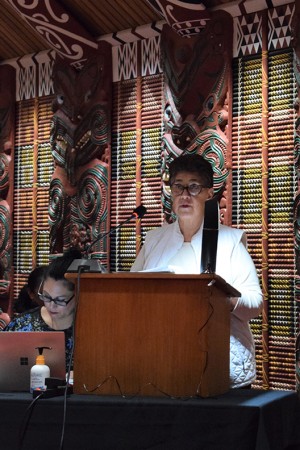
Merepeka Raukawa-Tait giving evidence at Te Mānuka Tūtahi Marae, Whakatāne
Whirimako Black
Whirimako Black MNZM (Ngāi Tūhoe, Ngāti Tūwharetoa, Ngāti Ranginui, Ngāti Kahungunu, Te Whakatōhea, Te Whānau-ā-Apanui, Te Arawa, Ngāti Awa, Te Ātihaunui-a-Pāpārangi) is a recording artist and actor. Her evidence focused on wāhine in her whakapapa, atua wāhine, the meaning of mana wāhine, and the balance between wāhine and tāne.
The Mana Wahine (Black) (Wai 2816) claim
Hearing four, Te Mānuka Tūtahi Marae, Whakatāne, July 2022
Read Whirimako Black's evidence (document A84)(external link)
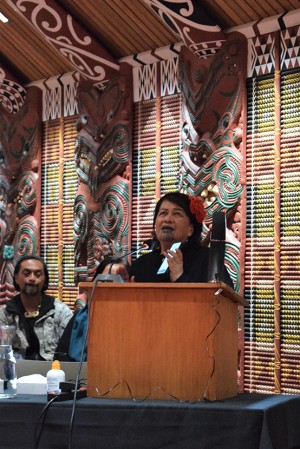
Whirimako Black giving evidence at Te Mānuka Tūtahi Marae, Whakatāne
Tracy Hillier
Tracy Hillier (Ngāi Tamahaua) presented as part of a panel with other members of her hapū – Kayreen Tapuke (her wife), Raiha Ruwhiu, and Genevieve Ruwhiu-Pupuke. Her evidence focused on three tipuna wāhine: Muriwai (a central tipuna of Ngai Tamahaua and Whakatōhea), Ani Karere (a korara and tipuna of Ngai Tamahaua), and Te Ao Putaputa. Her evidence also covered the importance of tamariki and whāngai, was well as wāhine roles in leadership, economics, war, and healing rituals.
Ngai Tamahaua (Biddle) (Wai 1781) claim
Hearing four, Te Mānuka Tūtahi Marae, Whakatāne, July 2022
Read Tracy Hillier's evidence (document A92)(external link)
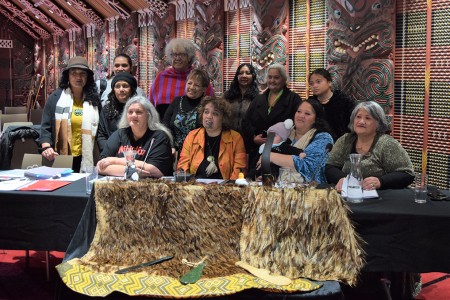
Front: Tracy Hillier, Kayreen Tapuke, Genevieve Ruwhiu-Pupuke, Raiha Ruwhiu
Kayreen Tapuke
Kayreen Tapuke (Ngai Tamahaua, Whakatōhea, Ngāi Tai, Ngāti Porou, Te Aitanga-a-Māhaki, Te Ātiawa and Taranaki whānui) has a background in teaching and is a member of Te Mana Motuhake o Ngāi Tamahaua Hapū and a trustee of Ngāi Tamahaua Trust. She gave evidence as part of a panel alongside her wife Tracy Hillier, as well as Raiha Ruwhiu and Genevieve Ruwhiu-Pupuke. Ms Tapuke’s evidence canvassed many aspects of Māori life before colonisation, including the importance of relationality and balance between wāhine and tāne; the role of wāhine as kaikaranga; wāhine atua and mātauranga-ā-wāhine; relationships, including same-sex relationships; the lack of toleration for rape; responses to childlessness, abortion, and unwanted children; and the role of ariki. She also discussed influential wāhine in her life.
Ngai Tamahaua (Biddle) (Wai 1781) claim
Hearing four, Te Mānuka Tūtahi Marae, Whakatāne, July 2022
Read Kayreen Tapuke's evidence (document A94)(external link)
Raiha Ruwhiu
Raiha Ruwhiu’s (Ngai Tamahaua) evidence covered Te Kauae Runga, the rankings of wāhine and tāne, birthing practices and menstruation, and moko kauae. She also discussed her tūpuna whaea Muriwai. She presented as part of a panel alongside her Ngāi Tamahaua whanaunga Tracy Hillier, Kayreen Tapuke, and Genevieve Ruwhiu-Pupuke (her daughter).
Ngai Tamahaua (Biddle) (Wai 1781) claim
Hearing four, Te Mānuka Tūtahi Marae, Whakatāne, July 2022
Read Raiha Ruwhiu's evidence (document A93)(external link)
Genevieve Ruwhiu-Pupuke
Genevieve Ruwhiu-Pupuke’s (Ngai Tamahaua and Whakatōhea) evidence included Muriwai and her whakapapa, the role of wāhine in pre-colonial times including leadership roles, and the stories of four of her wāhine tūpuna. She presented as part of a panel alongside her Ngāi Tamahaua whanaunga Tracy Hillier, Kayreen Tapuke, and Raiha Ruwhiu (her mother).
Ngai Tamahaua (Biddle) (Wai 1781) claim
Hearing four, Te Mānuka Tūtahi Marae, Whakatāne, July 2022
Read Genevieve Ruwhiu-Pupuke's evidence (document A102)(external link)
Katarina Jean Te Huia
Katarina Jean Te Huia (Ngāti Te Whatuiapiti, Ngāti Kahungunu) is a Māori midwife and nurse. Her evidence on mana wāhine focused on Hawaiki and the naming of Aotearoa, as well as wāhine Māori leadership roles. She described the various impacts of colonisation on wāhine.
The Māori Mothers (Wai 2823) claim
Hearing five, Waiwhetū Marae, Lower Hutt, August 2022
Read Katarina Jean Te Huia's evidence (document A115)(external link)
Michelle Marino
Michelle Marino (Ngāti Tama, Ngā Rauru) discussed wāhine in her whakapapa, as well as whakataukī that express mana wāhine; the practice of mahinga kai; childbirth and menstruation; matakite; and, the naming of people and places.
Kaiwharawhara and Hutt Valley Lands (Wai 377) claim
The Mana Wāhine (Marino and others) (Wai 2847) claim
Hearing five, Waiwhetū Marae, Lower Hutt, August 2022
Read Michelle Marino's evidence (document A111)(external link)
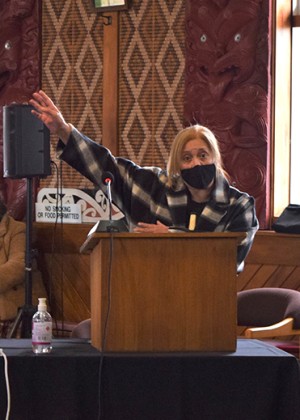
Michelle Marino giving evidence at Waiwhetū Marae, Lower Hutt
Patricia Henare
Patricia Henare (Ngāti Uenuku) gave evidence on atua whaea; the roles of wāhine and tāne deriving from tikanga; the meaning of mana wāhine and examples of wāhine Māori rangatira; the connection of wāhine to Papatūānuku; and, the skills they contributed to their iwi.
Makotuku Block IV (Wai 836) claim
Hearing five, Waiwhetū Marae, Lower Hutt, August 2022
Read Patricia Henare's evidence (document A104)(external link)
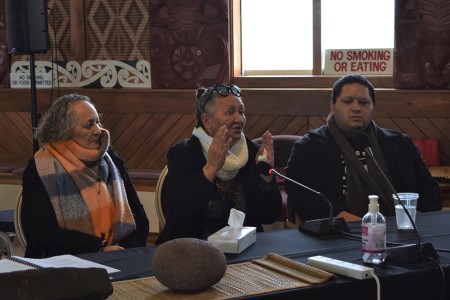
Patricia Henare (centre) giving evidence at Waiwhetū Marae, Lower Hutt
Hinemoa Ranginui-Mansell
Hinemoa Ranginui-Mansell (Te Atihaunui a Paparangi me Ngāti Apa, Ngāti Rangi, Ngāti Hinemanu, Te Whakatōhea, Ngāti Pikiao, Te Atiawa – Taranaki Whānui, me Ngāti Mutunga ki Wharekauri/Taranaki, Te Roroa, Ngāti Apa Ki Te Rā Tō and Ngāi Tahu) is a multidisciplinary artist. Her evidence highlighted several prominent wāhine and discussed their roles – including as holders of mātauranga, spiritual leaders, landowners, and military leaders. She also identified the treaty signatory 'Rere-ō-maki' as Rāwinia Rereō-Maki, a wāhine rangatira from Whanganui.
Te Wai Nui a Rua (Ranginui and Ranginui-Tamakehu (Wai 2157) claim
Hearing five, Waiwhetū Marae, Lower Hutt, August 2022
Read Hinemoa Ranginui-Mansell's evidence (document A129)(external link)
Elaine Bevan, Heeni Wilson, and Nganeko Wilson
Elaine Bevan, Jane Wilson, and Nganeko Wilson (Ngāti Raukawa, Ngāti Toa) delivered a joint brief of evidence about two of their wāhine rangatira tupuna: Waitohi (born late 1700s) and her daughter Te Rangitopeora (born early 1800s). They also commented on the high status of wāhine during this era.
The Mana Wahine (Durie) (Wai 2925) claim
Hearing five, Waiwhetū Marae, Lower Hutt, August 2022
Read Elaine Bevan, Heeni Wilson, and Nganeko Wilson's evidence (document A119)(external link)
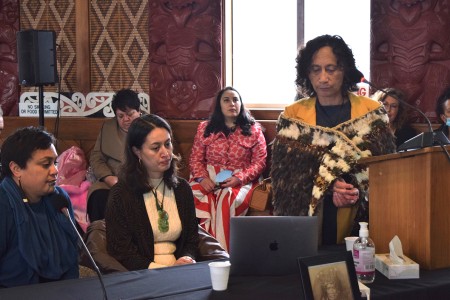
Heeni Wilson giving evidence at Waiwhetū Marae, Lower Hutt
Mereti Taipana
Mereti Taipana (Ngati Toa, Ngāti Rangatahi, Kāti Mamoe, Ngāti Kauwhata) gave evidence about two of her tūpuna wāhine rangatira: Wharekiri (born c. 1828) and Mihi-ki-Tūrangi Matawha (born 1836), commenting on the changing status of wāhine during this era.
The Mana Wahine (Durie) (Wai 2925) claim
Hearing five, Waiwhetū Marae, Lower Hutt, August 2022
Read Mereti Taipana's evidence (document A130)(external link)
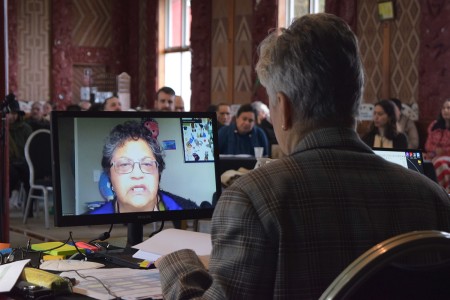
Mereti Taipana giving evidence virtually, pictured with Judge Sarah Reeves
Dennis Ngawhare Pounamu
Dennis Ngawhare Pounamu (Taranaki) gave evidence based on his Masters’ and PhD theses, and mātauranga-ā-iwi learned within the rohe of Taranaki. He highlighted four tūpuna kuia to illustrate te mana o te wāhine and rangatira wāhine: paearahi Rauhoto Tapairu, the tohunga Rahiri-mihia, the kuia Ueroa, and the leader Raumahora.
The Mana Wāhine (Pihama and others) (Wai 2872) claim
Hearing five, Waiwhetū Marae, Lower Hutt, August 2022
Read Dennis Ngawhare Pounamu's evidence (document A117)(external link)
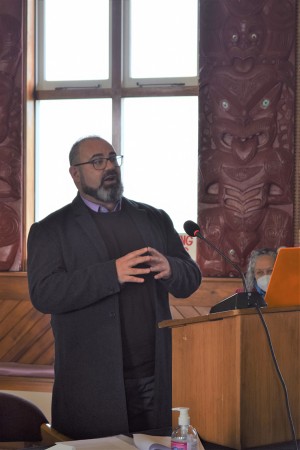
Dennis Ngawhare Pounamu giving evidence at Waiwhetū Marae, Lower Hutt
Aroaro Tamati
An active member of the Taranaki Māori community, Aroaro Tamati (Taranaki) is the Tumukāuru (Director) and a founding whanau member of Te Kōpae Piripono, a puna reo in New Plymouth. She highlighted how three tūpuna wāhine – Ueroa, Rākeitākiha, and Rauhoto Tapairu –showed the mana of wāhine in pre-colonial times. Her evidence also addressed the impact of colonisation on mana wāhine, with a particular focus on Parihaka.
The Mana Wāhine (Pihama and others) (Wai 2872) claim
Hearing five, Waiwhetū Marae, Lower Hutt, August 2022
Read Aroaro Tamati's evidence (document A131)(external link)
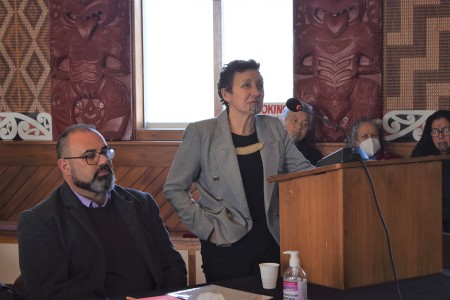
Aroaro Tamati giving evidence at Waiwhetū Marae, Lower Hutt, pictured with Dennis Ngawhare Pounamu (left)
Ngaropi Cameron
Ngaropi Cameron (Ngāti Mutunga, Ngāti Maru, Te Atiawa, Ngāti Toa Rangatira and Ngāti Kahungunu) is a founding member, current director, and research supervisor for Tū Tama Wāhine o Taranaki, with wide-ranging experience in health and social services. To showcase mana wāhine, her evidence detailed her tūpuna Rauhoto Tapairu, Hinetuhi, Rahiri Mihia, Te Ao Marama, and Kahe Te Rau o Te Rangi. She also discussed disruptions to mana wāhine due to colonisation, and present work on reasserting and recovering mana wāhine.
The Mana Wāhine (Pihama and others) (Wai 2872) claim
Hearing five, Waiwhetū Marae, Lower Hutt, August 2022
Read Ngaropi Cameron's evidence (document A113)(external link)
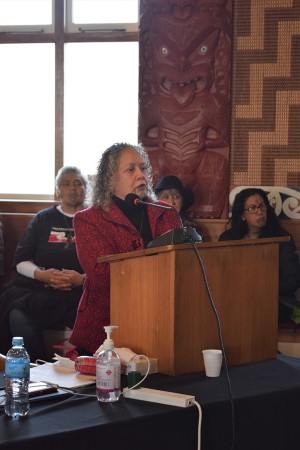
Ngaropi Cameron giving evidence at Waiwhetū Marae, Lower Hutt
Ripeka Hudson
Ripeka Hudson (Ngāruahinerangi) gave evidence drawn from conversations with whānau who whakapapa to Ngāruahinerangi. Her evidence detailed atua whaea and wāhine roles as puhi, navigators, and fishers. She also gave evidence on Ruaputahanga, a much-loved kuia tupuna of Taranaki, as well as discussing the impacts of colonisation – including the plundering of Parihaka.
The Mana Wāhine (Pihama and others) (Wai 2872) claim
Hearing five, Waiwhetū Marae, Lower Hutt, August 2022
Read Ripeka Hudson's evidence (document A128)(external link)
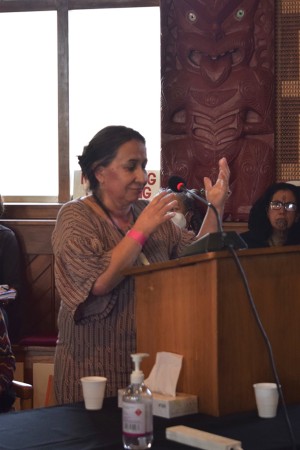
Ripeka Hudson giving evidence at Waiwhetū Marae, Lower Hutt
Keri Opai
Keri Opai (Te Atiawa, Ngāti Ruanui, Waiohua, Ngāti Te Ata, Ngāti Porou) is a linguist, teacher, and author, and the pou tikanga and co-deputy chief executive of Tui Ora, a Taranaki-based kaupapa Māori health service provider. His evidence focused on how gender-neutral language in te reo Māori indicates the mana of wāhine in pre-colonial Māori society.
The Mana Wāhine (Pihama and others) (Wai 2872) claim
Hearing five, Waiwhetū Marae, Lower Hutt, August 2022
Read Keri Opai's evidence (document A118)(external link)
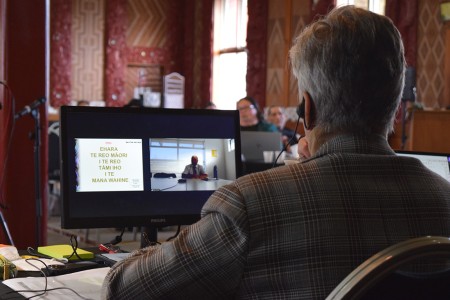
Keri Opai giving evidence virtually, pictured with Judge Sarah Reeves
Hera Black-Te Rangi and Mareta Taute
Hera Black-Te Rangi and Mareta Taute (Tūhoe) presented evidence together as mother and daughter. Their evidence focused on Hera’s upbringing, schooling, and the meanings of mana wāhine within Tūhoe, highlighting particular atua and kuia.
The Mana Wāhine (Pihama and others) (Wai 2872) claim
Hearing five, Waiwhetū Marae, Lower Hutt, August 2022
Read Hera Black-Te Rangi and Mareta Taute's evidence (document A116)(external link)
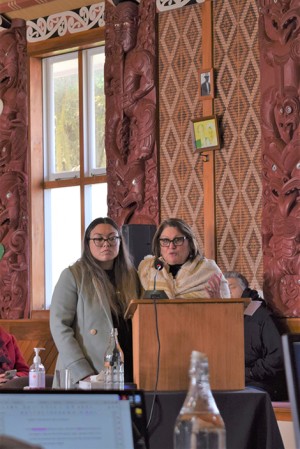
Mareta Taute (left) and Hera Black (right) giving evidence at Waiwhetū Marae, Lower Hutt
Dr Hiria Hape
Dr Hiria Hape (Tūhoe, Whakatōhea) is a karanga expert and gave evidence about the influence of wāhine in Tūhoe whakapapa, including Hinepūkohurangi (the mist maiden).
The Mana Wāhine (Pihama and others) (Wai 2872) claim
Hearing five, Waiwhetū Marae, Lower Hutt, August 2022
Read Dr Hiria Hape's evidence (document A114)(external link)
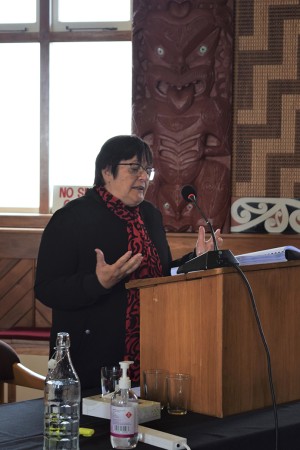
Dr Hiria Hape giving evidence at Waiwhetū Marae, Lower Hutt
Arapeta Wikitō Pōmare Hamilton
Arapeta Wikitō Pōmare Hamilton (Ngāti Manu, Te Uri Karaka and Te Uri o Raewera), a Ngāti Manu kaumātua, gave evidence about significant wāhine within his whakapapa. He emphasised the equality of wāhine and tāne in upholding whakapapa.
Tai Tokerau Land (Wai 354) claim
Hearing five, Waiwhetū Marae, Lower Hutt, August 2022
Read Arapeta Wikitō Pōmare Hamilton's evidence (document A123)(external link)
Marareia Hamilton
Marareia Hamilton (Ngāti Manu, Nga Whānau o Waitangi Horotutu me Taputaputa o Pahi, Ngāti Kawa, Ngāti Rāhiri, and Ngare Raumati) works in Māori economic development and teaches at Auckland University of Technology. Her evidence discussed the mana and rangatiratanga of wāhine in areas including the transmission of knowledge, the whare tangata, wairuatanga/connection to the spiritual realm, connection to the whenua (including through land ownership), entrepreneurship, and resilience.
Tai Tokerau Land (Wai 354) claim
Hearing five, Waiwhetū Marae, Lower Hutt, August 2022
Read Marareia Hamilton's evidence (document A121)(external link)
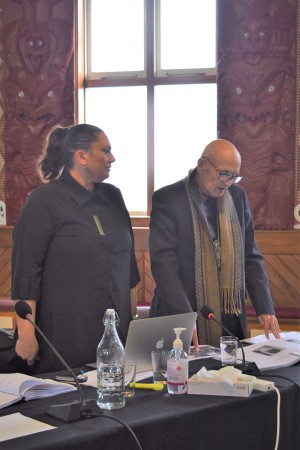
Marareira Hamilton (left) with Arapeta Hamilton (right)
Esme Sherwin
Esme Sherwin (Ngāpuhi, Nga Whānau o Waitangi Horotutu me Taputaputa o Pahi, Ngāti Kawa, Ngāti Rāhiri, and Ngare Raumati) is a trustee on Te Tii Waitangi Marae and has a background in sustainable rural development and horticulture. Her evidence told the stories of some of the influential wāhine in her life, and how they illustrate themes such as kaitiakitanga and karakia, strategic relationships, companionship, whāngai, birthing, justice, and balance in te ao Māori, as well as the roles of wāhine as knowledge-holders, teachers, and fighters.
Emma Gibbs & Whanau (Bay of Islands) (Wai 1477) claim
Hearing five, Waiwhetū Marae, Lower Hutt, August 2022
Read Esme Sherwin's evidence (document A110)(external link)
Heeni Collins
Heeni Collins (Ngāti Raukawa, Ngāti Huia, Ngāti Kikopiri, Ngāti Tukorehe, Ngāti Kauwhata, Ngāti Wehi Wehi) is a writer and researcher and holds several roles on community boards and trusts. Her evidence focused on Whakaotirangi, a wahine rangatira and tohunga. She also discussed marriage, whakapapa, and the balance between wāhine and tāne especially in relation to Io and atua. She presented alongside Stephanie Turner.
The Ngati Raukawa Ancestral Lands, Resources & Other property (Porter) (Wai 2419) claim
Hearing five, Waiwhetū Marae, Lower Hutt, August 2022
Read Heeni Collins's evidence (document A108)(external link)
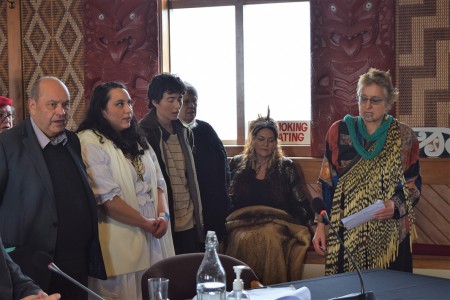
Heeni Collins (right) giving evidence at Waiwhetū Marae, Lower Hutt
Stephanie Turner
Stephanie Turner (Ngāti Raukawa, Ngāti Huia o Rangiuru, Ngāti Kikopiri) is the director of Māori health outcomes (Ahuahu Kanuku) at Te Tāhū Hauora, the Health Quality and Safety Commission. Her evidence focused on how tūpuna whaea demonstrated their mana in everyday life, as exemplified by her own tupuna whaea Te Ākau, a wahine rangatira. She presented alongside Heeni Collins.
The Ngati Raukawa Ancestral Lands, Resources & Other property (Porter) (Wai 2419) claim
Hearing five, Waiwhetū Marae, Lower Hutt, August 2022
Read Stephanie Turner's evidence (document A109)(external link)
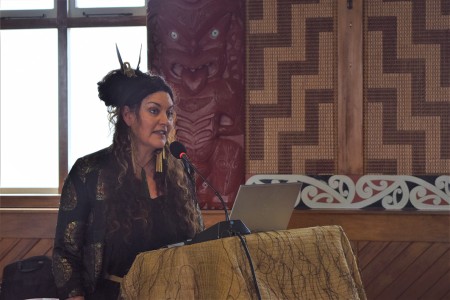
Stephanie Turner giving evidence at Waiwhetū Marae, Lower Hutt
Te Atawhai Te Rangi
Te Atawhai Te Rangi (Ngāti Porou, Ngāti Tuwharetoa) presented evidence informed by her Master’s thesis and based on lived experience of both domestic violence and abuse within gang culture. She focused on the status of wāhine in traditional Māori society and the balance between wāhine and tāne.
The Mana Wāhine (Women in gangs) (Wai 2874) claim
Hearing five, Waiwhetū Marae, Lower Hutt, August 2022
Read Te Atawhai Te Rangi's evidence (document A120)(external link)
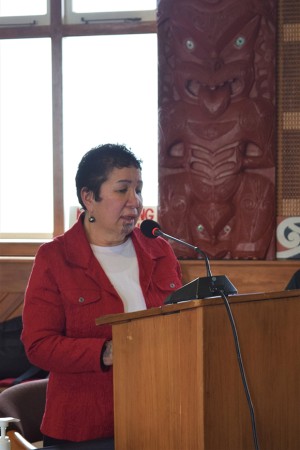
Te Atawhai Te Rangi giving evidence at Waiwhetū Marae, Lower Hutt
Hearing six
Professor Angela Wanhalla
Professor Angela Wanhalla (Ngāi Tahu) is an historian at the University of Otago. She specialises in Māori, New Zealand, and women’s history, especially the impacts of colonisation on Māori women, families, and communities. She has also published extensively on shore whaling in the 1830s, focusing on intermarriage between Māori and Pākehā and the contribution of Māori women to the industry through marriage alliances as well as their cultural expertise and knowledge. Drawing on her academic research, particularly from archival sources, her evidence demonstrated Māori women’s status, mana, leadership and authority in political and community life before 1840.
Ngai Tamatea Hapu ki Waiotahe Lands (Wai 1511) claim
The Mana Wahine (Ormsby and Kurarangi) (Wai 3011) claim
Hearing six, Ngā Hau E Whā, Christchurch, September 2022
Read Professor Angela Wanhalla's evidence (document A82)(external link)
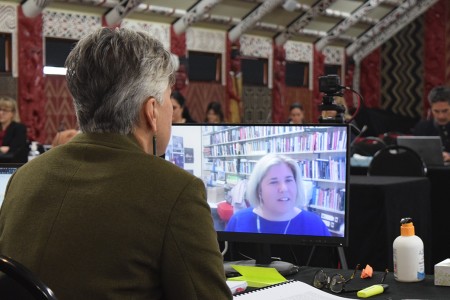
Professor Angela Wanhalla presenting evidence virtually, pictured with Judge Sarah Reeves
Tiaho Mary Pillot
Tiaho Mary Pillot (Ngāti Hotu) presented evidence focusing on significant Ngāti Hotu women, including Tiahuia Ruby Te Ahuru (her grandmother), Hinekapa (a Ngāti Hotu chief), Hinemihi (a prominent wāhine), Rangikowaea Te Wharerangi (a rangatira and tohunga/ matakite and her great-grandmother x 7), Te Maari II (a spiritually gifted tohunga, matakite). She also covered wāhine spiritual relationship as kaitiaki with their local mountains, rivers, and streams, and their role in harvesting mutton-birds and food preparation for Te Wharerangi. She said her evidence should be read in conjunction with evidence presented by her sister Maata Merle Ormsby (nee Patena) and nephew Daniel Ormsby.
Tongariro Power Development Scheme Lands (Wai 1196) claim
Hearing six, Ngā Hau E Whā, Christchurch, September 2022
Read Tiaho Mary Pillot's evidence (document A91)(external link)
Merle Maata Ormsby & Daniel Whetu Ormsby
Merle Maata Ormsby and Daniel Whetu Ormsby (Ngāti Hikairo) presented their evidence together. They canvassed the role of kaitiaki and prominent wāhine including Parerohi Sullivan (a rangatira of Ngāti Hikairo), Kiekie (Pareohi’s daughter), Rangikowaea (an esteemed leader), Te Maari II (Rangikowaea’s daughter), Hinemihi (a great chieftainess), and Tarihira (daughter of Captain Biggs).
Tongariro Power Development Scheme Lands (Wai 1196) claim
Hearing six, Ngā Hau E Whā, Christchurch, September 2022
Read Merle Maata Ormsby and Daniel Whetu Ormsby's evidence (document A133)(external link)
Puti Corbett
Puti Corbett (Waitaha) is a family violence and sexual violence specialist. Her evidence focused on her taonga tupuna whaea, Te Auparo, whose story, she said, shows domestic violence was unacceptable in te ao Māori. Ms Corbett also highlighted the experiences of her grandmother, Puti Noema Rewiri Ahitapu, to demonstrate how wāhine hold whenua in Ngāpuhi tikanga.
Waitaha (Te Korako and Harawira) (Wai 1940) claim
Hearing six, Ngā Hau E Whā, Christchurch, September 2022
Read Puti Corbett's evidence (document A83)(external link)
Jane Ruka
The evidence of Jane Ruka (Waitaha) comprised mana wāhine stories of the Waitaha Grandmother Council. She covered atua whaea and tupuna whaea and described the life experiences of her mother and grandmother.
Waitaha (Te Korako and Harawira) (Wai 1940) claim
Hearing six, Ngā Hau E Whā, Christchurch, September 2022
Read Jane Ruka's evidence (document A135)(external link)
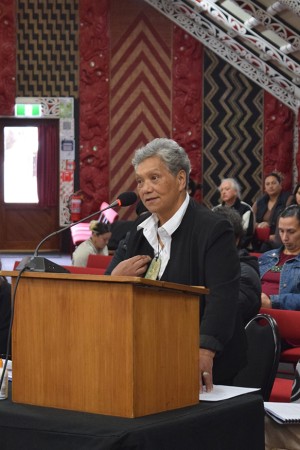
Jane Ruka giving evidence at Ngā Hau E Whā, Christchurch
Aroha Rickus
Aroha Rickus (Waitaha) is the founder of Irichouse Te Pātaka and co-founder of Te Reo Pūrākau o te Oriori. Her evidence focused on the roles and status of tūpuna wāhine, atua wāhine, te reo rangatira, and tikanga.
Waitaha (Te Korako and Harawira) (Wai 1940) claim
Hearing six, Ngā Hau E Whā, Christchurch, September 2022
Read Aroha Rickus's evidence (document A140)(external link)
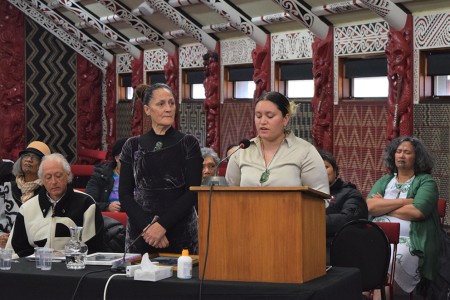
Aroha Rickus (left) at Ngā Hau E Whā, Christchurch
Elle Archer
Elle Archer (Ngāti Tamaterā, Ngāi Tūhoe, Ngāti Porou, and Ngāpuhi) is a professional director, governance professional, and PhD candidate at the University of Canterbury. She gave evidence on behalf of the Waitaha Grandmother Council about wāhine rangatiratanga before colonisation.
Waitaha (Te Korako and Harawira) (Wai 1940) claim
Hearing six, Ngā Hau E Whā, Christchurch, September 2022
Read Elle Archer's evidence (document A154(a))(external link)
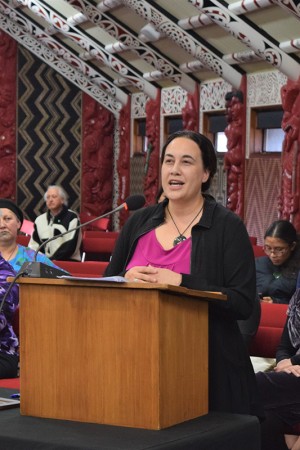
Elle Archer giving evidence at Ngā Hau E Whā, Christchurch
Ema Weepu
Ema Weepu (Waitaha, Ngāi Tahu, Ngāti Mamoe) is a rongoā practitioner, whose lifetime involvement in Māori activism includes advocating for the rights of her Waitaha hapū. She gave evidence about Waitaha traditional narratives.
Waitaha (Te Korako and Harawira) (Wai 1940) claim
Hearing six, Ngā Hau E Whā, Christchurch, September 2022
Read Ema Weepu's evidence (document A136)(external link)
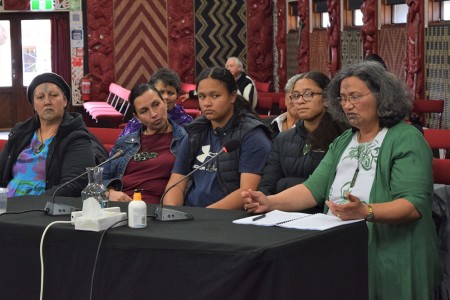
Ema Weepu (right) presenting evidence at Ngā Hau E Whā, Christchurch, alongside her whānau
Mere Skerrett
Associate Professor Mere Skerrett (Waitaha) has a background as a teacher and researcher in both the early childhood and primary education, with a focus on Kōhanga Reo and Māori/English bilingualism. Her evidence canvassed her whakapapa and spoke to the balance between wāhine and tāne; wāhine rangatiratanga over whenua, whakapapa/whānau, whai rawa, and mātauranga; and raising tamariki.
Waitaha (Te Korako and Harawira) (Wai 1940) claim
Hearing six, Ngā Hau E Whā, Christchurch, September 2022
Read Mere Skerrett's evidence (document A137)(external link)
Ngaronoa Kimura
Ngaronoa Kimura (Waitaha) is a lactation consultant who works particularly with Māori and Pacific mothers. Her evidence was on atua whāea, te whare tangata, birthing practices, menstruation, and breast feeding.
Waitaha (Te Korako and Harawira) (Wai 1940) claim
Hearing six, Ngā Hau E Whā, Christchurch, September 2022
Read Ngaronoa Kimura's evidence (document A139)(external link)
Paihere Clarke
Paihere Clarke (Waitaha) works with various government agencies working to re-engage Māori and Pacific Islanders with education and employment. She discussed atua whaea, the balance between wāhine and tāne, wāhine rangatira over whenua, whakapapa, whai rawa, and matauranga, the significance of the whenua and te whare tangata, and whāngai.
Waitaha (Te Korako and Harawira) (Wai 1940) claim
Hearing six, Ngā Hau E Whā, Christchurch, September 2022
Read Paihere Clarke's evidence (document A141)(external link)
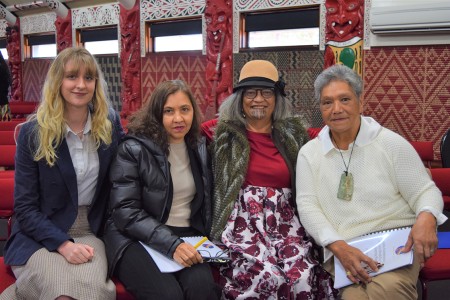
Paihere Clarke (in red) with lawyers Gretta Hansen and Janet Mason (left) and Jane Ruka (right)
Sharon Barber
Sharon (Iri) Barber (Waitaha) gave evidence in support of the Waitaha Grandmaother Council’s claim. She told the Tribunal about her rangatira wāhine ancestors including Papakura, Moroiti, Nihorere, and Hinetaumai.
Waitaha (Te Korako and Harawira) (Wai 1940) claim
Hearing six, Ngā Hau E Whā, Christchurch, September 2022
Read Sharon Barber's evidence (document A138)(external link)
Naomi Simmonds
Dr Naomi Simmonds (Ngāti Raukawa) is a writer and researcher at Te Whare Wānanga o Awanuiārangi. Her evidence focused on Māhinaarangi and her journey, whilst heavily pregnant, from the lands of her people in Kahungunu to those of her husband, Tūrongo, at Rangiātea, a journey Dr Simmonds retraced as part of a Marsden Grant Research Project. Dr Simmonds said her research had given her insights into the relationship between whenua and mana wahine, the ways in which Māori maternal knowledges and practices are embedded within the land and language, the impact of colonialism on Māori maternities and specifically on Māhinaarangi’s descendants, and challenges and opportunities for wāhine in the reclamation of place-based knowledges.
The Mana Wāhine (Pihama and others) (Wai 2872) claim
Hearing six, Ngā Hau E Whā, Christchurch, September 2022
Read Naomi Simmonds's evidence (document A134)(external link)
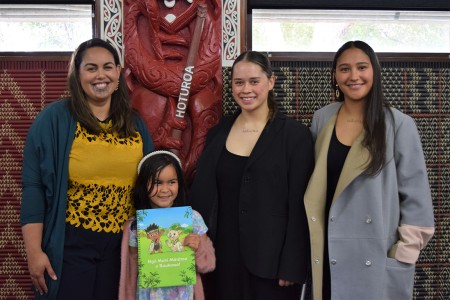
Naomi Simmonds with her daughter, and whānaunga K'lee and Tyra Begbie
Dr Byron Rangiwai
Dr Byron Rangiwai (Ngāi Tūhoe, Ngāti Porou, Ngāti Manawa, Ngāti Whare) has an academic background in Māori development, indigenous studies, digital business, and design. Dr Rangiwai’s evidence focused on gender fluidity, diversity, and sexuality in pre-colonial te ao Māori, as well as the origins and meaning of the term takatāpui.
The Mana Wāhine (Pihama and others) (Wai 2872) claim
Hearing six, Ngā Hau E Whā, Christchurch, September 2022
Read Dr Byron Rangiwai's evidence (document A146)(external link)
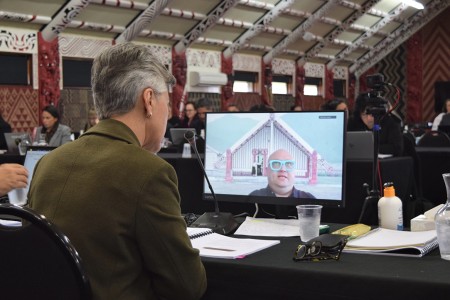
Dr Byron Rangiwai presenting evidence virtually, pictured with Judge Sarah Reeves
Hira Huata
Hira Huata (Ngāti Kahungunu) is a teacher, a speaker for her iwi, hapū, and marae, a painter, and weaver of taniko, tukutuku, and kakahu. Her evidence concerned Māori spirituality and cosmology.
The Mana Wāhine (Pihama and others) (Wai 2872) claim
Hearing six, Ngā Hau E Whā, Christchurch, September 2022
Read Hira Huata's evidence (document A149)(external link)
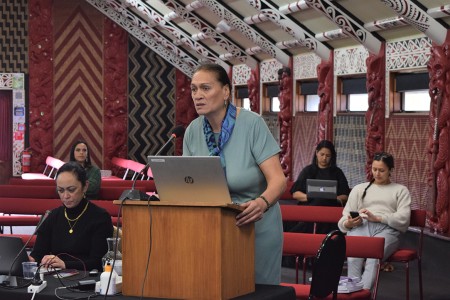
Hira Huata giving evidence at Ngā Hau E Whā, Christchurch
Christine Harvey and Rangi Kipa
Christine Harvey (Rekohu, Ngāti Mutunga) and Rangi Kipa (Te Āti Awa, Taranaki) are moko kauae practitioners and gave evidence on the practice in traditional and contemporary contexts.
The Mana Wāhine (Pihama and others) (Wai 2872) claim
Hearing six, Ngā Hau E Whā, Christchurch, September 2022
Read Christine Harvey and Rangi Kipa's evidence (document A147)(external link)
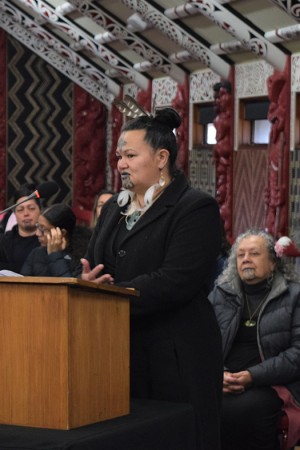
Christine Harvey giving evidence at Ngā Hau E Whā, Christchurch
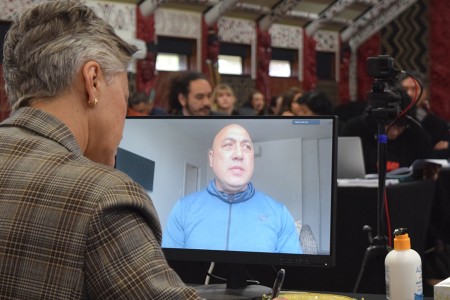
Rangi Kipa giving evidence virtually, pictured with Judge Sarah Reeves
Te Rua Wallace
Te Rua Wallace (Te Arawa, Tūwharetoa,Te Atihaunui-a-Pāpārangi) gave evidence focused on Hineahuone, Hinetītama, and Hinenuitepō.
The Mana Wāhine (Pihama and others) (Wai 2872) claim
Hearing six, Ngā Hau E Whā, Christchurch, September 2022
Read Te Rua Wallace's evidence (document A151)(external link)
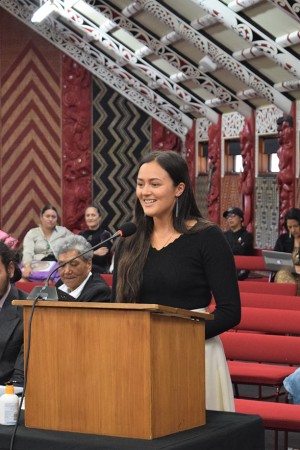
Te Rua Wallace giving evidence at Ngā Hau E Whā, Christchurch
Dallas King
Dallas King (Te Hikutū) is a Hokianga hapū spokesperson. Her evidence focused on wāhine in her life, as well as atua and tūpuna whaea in Te Hikutū histories.
Whirinaki Lands and Waters (Hokianga) (Wai 700) claim
Hearing six, Ngā Hau E Whā, Christchurch, September 2022
Read Dallas King's evidence (document A150(a))(external link)
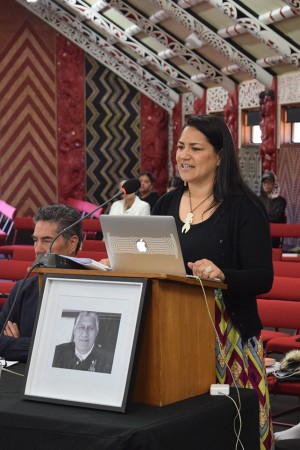
Dallas King giving evidence at Ngā Hau E Whā, Christchurch
Nora Rameka
Nora Rameka MNZM (Ngāpuhi, Ngāti Rehia) is an education advisor. Her evidence surveyed the traditions and stories of Ngāti Rēhia wāhine ancestors and leaders.
The Mana Wahine (Allen) (Wai 3003) claim
Hearing six, Ngā Hau E Whā, Christchurch, September 2022
Read Nora Rameka's evidence (document A152)(external link)
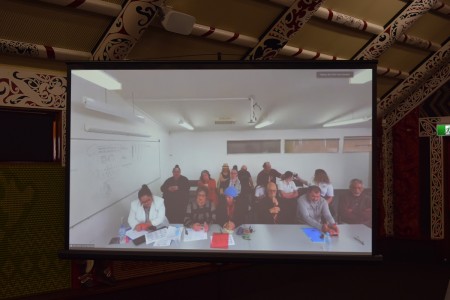
Nora Rameka giving evidence virtually, appearing with whānau
